#published: 2015 to 2019
Explore tagged Tumblr posts
Text
Life Happens
Authour: @cdelphiki
Subfandom: Batman
Media: Comics
Relationships: Gen (Tim Drake & Damian Wayne)
Year: 2018
Rating: Gen
Warnings: Unknown
Summary:
While walking home from an event at Wayne Enterprises, Tim and Damian are kidnapped and sent to an alternate dimension. In a world where superheroes are merely comic book characters and the idea of the multiverse is only a theory found within the pages of science fiction, how are Tim and Damian going to return home? How long will they be stranded on this strange Earth? And will the boys murder each other before they figure it out?
Submitted by anon
Submitter's comment:
Oh it is so goooood. Tim and Damian stuck in our world, building a life from scratch. Brilliant bonding and I haven't been able to stop thinking about it since I read it.
#batman#media: comics#published: 2015 to 2019#gen#DC fic recs#Cdelphiki#this is in my drafts!#you beat me to it!
48 notes
·
View notes
Text
What is going on?! There has been little new music coming out from bands I love pretty much since covid at least, and now, there's not only a new Megaherz album but within a few days also the new ASP album, a new Oomph! album, a new song from PAIN and a new Indica song for the first time in like ten years???
#like seriously what's going on#i think sabaton and powerwolf were the only ones of my big old loves really putting out new music#(most of which i admittedly wasn't too fond of tbh)#and asp of course did put out some songs and the last album is 'only' two years old#but megaherz and oomph published their last album in... 2018/2019 or something?#the last pain album is from 2015 or 2016 i think#and indica have been dormant literally since 2013 or 2014 i sincerely thought they disbanded#sooo much new music i'm thriving#and also fighting the impulse to get tickets for the pain tour because again. peter seems to have drifted to the right#and i don't wanna give him money#music#kaj rambles#to delete later
5 notes
·
View notes
Text
I should be asleep
(Working a clopen,,, rip,, I need to be awake in like 6.5 hrs)
But I got hit w the "gotta write gotta write gotta write" energy. So I uh. Did some writing
And now Chapter 2 is done
Word count!!!
Chapter 1 - 1,597
Chapter 2 - 1,772
Total thus far - 3,369
#listen. i havent written any fic of any kind since november 2019. this is nice.#its stupid self indulging stuff mkay#Im gonna publish it tho its fun#its just Project M6 having a bad time again but this time its multi chapter!!#hell idk when the last time I did a multi chapter piece was. fuckign. 2015 or earlier probably-#yeah so its a call of duty crossover with the MCU (sorta) bc I just wanted to throw M6 in there.#MongoosePosting.txt
0 notes
Text
Nimona: a Story of Trans Rights, Queer Solidarity, and the Battle Against Censorship
by Ren Basel renbasel.com
The 2023 film Nimona, released on Netflix after a tumultuous development, is a triumph of queer art. While the basic plot follows a mischievous shapeshifter befriending a knight framed for murder, at its heart Nimona is a tale of queer survival in the face of bigotry and censorship. Though the word “transgender” is never spoken, the film is a deeply political narrative of trans empowerment.
The film is based on a comic of the same name, created by Eisner-winning artist N.D. Stevenson. (1) Originally a webcomic, Nimona stars the disgraced ex-knight Ballister Blackheart and his titular sidekick, teaming up to topple an oppressive regime known as the Institution. The webcomic was compiled into a graphic novel published by Harper Collins on May 12, 2015. (2)
On June 11, 2015, the Hollywood Reporter broke the news Fox Animation had acquired rights to the story. (3) A film adaptation would be directed by Patrick Osborne, written by Marc Haimes, and produced by Adam Stone. Two years later, on February 9, 2017, Osborne confirmed the film was being produced with the Fox-owned studio Blue Sky Animation, and on June 30 of that same year, he claimed the film would be released Valentine’s Day 2020. (4)
Then the Walt Disney Company made a huge mess.
On December 14, 2017, Disney announced the acquisition of Twenty-First Century Fox, Inc. (5) Industry publications began speculating the same day about Blue Sky’s fate, though nothing would be confirmed until after the deal’s completion on March 19, 2019. (6) At first it seemed the studio would continue producing films under Disney’s governance, similar to Disney-owned Pixar Animation. (7)
The fate of the studio—and Nimona’s film adaptation—remained in purgatory for two years. During that time, Patrick Osborne left over reported creative differences, and directorial duties were taken over by Nick Bruno and Troy Quane. (8) Bruno and Quane continued production on the film despite Blue Sky’s uncertain future.
The killing blow came on February 9, 2021. Disney shut down Blue Sky and canceled Nimona, the result of economic hardship caused by COVID-19. (9) Nimona was seventy-five percent completed at the time, set to star Chloë Grace Moretz and Riz Ahmed. (10)
While COVID-19 caused undeniable financial upheaval for the working class, wealthy Americans fared better. (11) Disney itself scraped together enough to pay CEO Bob Iger twenty-one million dollars in 2020 alone. (12) Additionally, demand for animation spiked during the pandemic’s early waves, and Nimona could have been the perfect solution to the studio’s supposed financial woes. (13) Why waste the opportunity to profit from Blue Sky’s hard work?
It didn’t take long for the answer to surface. Speaking anonymously to the press, Blue Sky workers revealed the awful truth: Disney may have killed Nimona for being too queer. The titular character was gender-nonconforming, the leading men were supposed to kiss, and Disney didn’t like it. (14) While Disney may claim COVID-19 as the cause, it is noteworthy that Disney representatives saw footage of two men declaring their love, and not long after, the studio responsible was dead. (15) Further damning evidence came in February of 2024, when the Hollywood Reporter published an article quoting co-director Nick Bruno, who named names: Disney’s chief creative officer at the time, Alan Horn, was adamantly opposed to the film’s “gay stuff.” (16)
Disney didn’t think queer art was worthy of their brand, and it isn’t the first time. “Not fitting the Disney brand” was the justification for canceling Dana Terrace’s 2020 animated series The Owl House, which featured multiple queer characters. (17) Though Terrace was reluctant to assume queerphobia caused the cancellation, Disney’s anti-queer bias has been cited as a hurdle by multiple showrunners, including Terrace herself. (18) The company’s resistance to queer art is a documented phenomenon.
While Nimona’s film cancellation could never take N.D. Stevenson’s comic from the world, it was a sting to lose such a powerful queer narrative on the silver screen. American film has a long history of censoring queerness. The Motion Picture Production Code (commonly called the Hays Code) censored queer stories for decades, including them under the umbrella of “sex perversion.” (19) Though the Code was eventually repealed, systemic bigotry turns even modern queer representation milestones into battles. In 2018, when Rebecca Sugar, creator of the Cartoon Network series Steven Universe, succeeded in portraying the first-ever same-sex marriage proposal in American children’s animation, the network canceled the show in retaliation. (20)
When queer art has to fight so hard just to exist, each loss is a bitter heartbreak. N.D. Stevenson himself expressed sorrow that the world would never see what Nimona’s crew worked so hard to achieve. (21)
Nimona, however, is hard to kill.
While fans mourned, progress continued behind the scenes. Instead of disappearing into the void as a tax write-off, the film was quietly scooped up by Megan Ellison of Annapurna Pictures. (22) Ellison received a call days before Disney’s death blow to Blue Sky, and after looking over storyboard reels, she decided to champion the film. With Ellison’s support, former Blue Sky heads Robert Baird and Andrew Millstein did their damnedest to find Nimona a home. (23)
Good news arrived on April 11, 2022, when N.D. Stevenson made a formal announcement on Twitter (now X): Nimona was gloriously alive, and would release on Netflix in 2023. (24) Netflix confirmed the news in its own press release, where it also provided details about the film’s updated cast and crew, including Eugene Lee Yang as Ambrosius Goldenloin alongside Riz Ahmed’s Ballister Boldheart (changed from the name Blackheart in the comic) and Chloë Grace Moretz as Nimona. (25) The film was no longer in purgatory, and grief over its death became anticipation for its release.
Nimona made her film debut in France, premiering at the Annecy International Animation Film Festival on June 14, 2023 to positive reviews. (26) Netflix released the film to streaming on June 30, finally completing the story’s arduous journey from page to screen. (27)
When the film begins, the audience is introduced to the world through a series of illustrated scrolls, evoking the storybook intros of Disney princess films such as 1959’s Sleeping Beauty. The storybook framing device has been used to parody Disney in the past, perhaps most famously in the 2001 Dreamworks film Shrek. Just as Shrek contains parodies of the Disney brand created by a Disney alumnus, so, too, does Nimona riff on the studio that snubbed it. (28)
Nimona’s storybook intro tells the story of Gloreth, a noble warrior woman clad in gold and white, who defended her people from a terrible monster. After slaying the beast, Gloreth established an order of knights called the Institute (changed from the Institution in the comic) to wall off the city and protect her people.
Right away, the film introduces a Christian dichotomy of good versus evil. Gloreth is presented as a Christlike figure, with the Institute’s knights standing in as her saints. (29) Her name is invoked like the Christian god, with characters uttering phrases such as “oh my Gloreth” and “Gloreth guide you.” The film’s design borrows heavily from Medieval Christian art and architecture, bolstering the metaphor.
Nimona takes place a thousand years after Gloreth’s victory. Following the opening narration, the audience is dropped into a setting combining Medieval aesthetics with futuristic science fiction, creating a sensory delight of neon splashed across knights in shining armor. It’s in this swords-and-cyborgs city that a new knight is set to join the illustrious ranks of Gloreth’s Institute, now under the control of a woman known only as the Director (voiced by Frances Conroy). That new knight is our protagonist, Ballister Boldheart.
The film changes several things from the original. The comic stars Lord Ballister Blackheart, notorious former knight, long after his fall from grace. He has battled the Institution for years, making a name for himself as a supervillain. The film introduces a younger Ballister Boldheart who is still loyal to the Institute, who believes in his dream of becoming a knight and overcomes great odds to prove himself worthy. In the comic, Blackheart’s greatest rival is Sir Ambrosius Goldenloin, with whom he has a messy past. The film shows more of that past, when Goldenloin and Boldheart were young lovers eager to become knights by each other’s side.
There is another notable change: in the comic, Goldenloin is white, and Blackheart is light-skinned. In the film, both characters are men of color—specifically, Boldheart is of Pakistani descent, and Goldenloin is of Korean descent, matching the ethnicity of their respective voice actors. This change adds new themes of institutional racism, colorism, and the “model minority” stereotype. (30)
The lighter-skinned Goldenloin is, as his name suggests, the Institute’s golden boy. He descends from the noble lineage of Gloreth herself, and his face is emblazoned on posters and news screens across the city. He is referred to as “the most anticipated knight of a generation.” In contrast, the darker-skinned Boldheart experiences prejudice and hazing due to his lower-class background. His social status is openly discussed in the news. He is called a “street kid” and “controversial,” despite being the top student in his class. The newscasters make sure everyone knows he was only given the chance to prove himself in the Institute because the queen, a Black woman with established social influence, gave him her personal patronage. Despite this patronage, when the news interviews citizens on the street, public opinion is firmly against Boldheart.
To preserve the comic’s commentary on white privilege, some of Goldenloin’s traits were written into a new, white character created for the film, Sir Thoddeus Sureblade (voiced by Beck Bennett). Sureblade’s vitriol against both Boldheart and Goldenloin allowed Goldenloin to become a more sympathetic character, trapped in the system just as much as Boldheart. (31) This is emphasized at other points in the film when the audience sees Sureblade interact with Goldenloin without Boldheart present, berating the only person of color left in the absence of the darker-skinned man.
The day Boldheart is to be knighted, everything goes wrong. As Queen Valerin (voiced by Lorraine Toussaint) performs the much-anticipated knighting ceremony, a device embedded in Boldheart’s sword explodes, killing her instantly. Though Boldheart is not to blame, he is dubbed an assassin instead of a knight. In an instant, he becomes the most wanted man in the kingdom, and Queen Valerin’s hopes for progress and social equality seem dead with her. Boldheart is gravely injured in the explosion and forced to flee, unable to clear his name.
Enter Nimona.
The audience meets the titular character in the act of vandalizing a poster of Gloreth, only to get distracted by an urgent broadcast on a nearby screen. As she approaches, a bystander yells that she’s a “freak,” in a manner reminiscent of slurs screamed by passing bigots. Nimona has no time for bigots, spraying this one in the face with paint before tuning in to the news.
“Everyone is scared,” declare the newscasters, because queen-killer Ballister Boldheart is on the run. The media paints him as a monster, a filthy commoner who never deserved the chances he was given, and announce that, “never since Gloreth’s monster has anything been so hated.” This characterization pleases Nimona, and she declares him “perfect” before scampering off to find his hiding place.
It takes the span of a title screen for her to track him down, sequestered in a makeshift junkyard shelter. Just before Nimona bursts into the lair, the audience sees Boldheart’s injuries have resulted in the amputation of his arm, and he is building a homemade prosthetic. This is another way he’s been othered from his peers in an instant, forced to adapt to life-changing circumstances with no support. Where he was so recently an aspiring knight with a partner and a dream, he is now homeless, disabled, and isolated.
A wall in the hideout shows a collection of news clippings, suspects, and sticky notes where Boldheart is trying to solve the murder and clear his name. His own photo looks down from the wall, captioned with a damning headline: “He was never one of us—knights reveal shocking details of killer’s past.” It evokes real-world racial bias in crime reporting, where suspects of color are treated as more violent, unstable, and prone to crime than white suspects. A 2021 report by the Equal Justice Initiative and the Global Strategy Group compiled data on this phenomenon, focusing on the stark disparity between coverage of white and Black suspects. (32)
Nimona is not put off by Boldheart’s sinister media reputation. It’s why she tracked him down in the first place. She’s arrived to present her official application as Boldheart’s villain sidekick and help him take down the Institute. Boldheart brushes her off, insisting he isn’t a villain. He has faith in his innocence and in the system, and leaves Nimona behind to clear his name.
When he is immediately arrested, stripped of his prosthetic, and jailed, Nimona doesn’t abandon him. She springs a prison break, and conveys a piece of bitter wisdom to the fallen knight: “[O]nce everyone sees you as a villain, that’s what you are. They only see you one way, no matter how hard you try.”
Nimona and Boldheart are both outcasts, but they are at different stages of processing the pain. Boldheart is deep in the grief of someone who tried to adhere to the demands of a biased system but finally failed. He is the newly cast-out, who gave his entire life to the system but still couldn’t escape dehumanization. His pain is a fresh, raw wound, where Nimona has old scars. She embodies the deep anger of those who have existed on the margins for years. Where Boldheart wants to prove his innocence so he can be re-accepted into the fold, Nimona’s goal is to tear the entire system apart. She finds instant solidarity with Boldheart based solely on their mutual status as outsiders, but Boldheart resists that solidarity because he still craves the system’s familiar structure.
In the comic, Blackheart’s stance is not one of fresh grief, since, just like Nimona, he has been an outsider for some time. Instead, Blackheart’s position is one of slow reform. He believes the system can be changed and improved, while Nimona urges him to demolish it entirely. In both versions, Ballister thinks the system can be fixed by removing specific corrupt influences, where Nimona believes the government is rotten to its foundations and should be dismantled. Despite their ideological differences, Nimona and Ballister ally to survive the Institute’s hostility.
The allyship is an uneasy truce. During the prison break, Nimona reveals that she’s a shapeshifter, able to change into whatever form she pleases. Boldheart reflexively reaches for his sword, horrified that she isn’t human. She is the exact sort of monster he has been taught to fear by the Institute, and it’s only because he needs her help that he overcomes his reflex and sticks with her.
Nimona’s shapeshifting functions as a transgender allegory. The comic’s author, N.D. Stevenson, is transgender, and Nimona’s story developed alongside his own queer journey. (33) The trans themes from the comic are emphasized in the film, with various pride flags included in backgrounds and showcased in the art book. (34) Directors Bruno and Quane described the film as “a story about acceptance. A movie about being seen for who you truly are and a love letter to all those who’ve ever shared that universal feeling of being misunderstood or like an outsider trying to fit in.” (35)
When Boldheart asks Nimona what she is, she responds with only “Nimona.” When he calls her a girl, she retorts that she’s “a lot of things.” When she transforms into another species, she specifies in that moment that she’s “not a girl, I’m a shark.” Later, when she takes the form of a young boy and Boldheart comments on it, saying “now you’re a boy,” her response is, “I am today.” She defies easy categorization, and she likes it that way.
About her shapeshifting, Nimona says “it feels worse if I don’t do it” and “I shapeshift, then I’m free.” When asked what happens if she doesn’t shapeshift, she responds, “I wouldn’t die-die, I just sure wouldn’t be living.” Every time she discusses her transformations, it carries echoes of transgender experience—and, as it happens, Nimona is not N.D. Stevenson’s only shapeshifting transgender character. During his tenure as showrunner for She-Ra and the Princesses of Power (Netflix/Dreamworks, 2018-2020), Stevenson introduced the character Double Trouble. Double Trouble previously existed at the margins of She-Ra lore, but Stevenson’s version was a nonbinary shapeshifter using they/them pronouns. (36) While Nimona uses she/her pronouns throughout both comic and film, just like Double Trouble her gender presentation is as fluid as her physical form.
Boldheart, like many cisgender people reacting to transgender people, is uncomfortable with Nimona. He declares her way of doing things “too much,” and insists they try to be “inconspicuous” and “discreet.” He worries whether others saw her, and, when she is casually in a nonhuman form, he asks if she can “be normal for a second.” He claims to support her, but says it would be “easier if she was a girl” because “other people aren’t as accepting.” His discomfort evokes fumbled allyship by cisgender people, and Nimona emphasizes the allegory by calling Boldheart out for his “small-minded questions.” While the alliance is uneasy, Boldheart continues working with Nimona to clear his name. They are the only allies each other has, and their individual survival is dependent on them working together.
When the duo gain video proof of Boldheart’s innocence, they learn the bomb that killed Queen Valerin was planted by the Director. Threatened by a Black woman using her influence to elevate a poor, queer man of color, the white Director chose to preserve the status quo through violence.
Nimona is eager to get the video on every screen in the city, but Boldheart wants to deal with the issue internally, out of the public eye. He insists “the Institute isn’t the problem, the Director is.” This belief is what also leads the comic’s Blackheart to reject Nimona’s idea that he should crown himself king. He is focused on reforming the existing power structure, neither removing it entirely nor taking it over himself.
Inside the Institute, the Director has been doing her best to set Goldenloin against his former partner. Despite his internal misgivings and fear of betraying someone he loves, Goldenloin does his best to adhere to his prescribed role. As the Director reminds the knights, they are literally born to defend the kingdom, and it’s their sacred duty to do so—especially Goldenloin, who carries Gloreth’s holy blood. This blood connection is repeated throughout the film, and used by the Director to exploit Goldenloin. He’s the Institute’s token minority, put on a gilded pedestal and treated as a symbol instead of a human being.
Goldenloin is a pretty face for propaganda posters, and those posters can be seen throughout the film. They proclaim Gloreth’s majesty, the power of the knights, and remind civilians that the Institute is necessary to “protect our way of life.” A subway PSA urges citizens, “if you see something, slay something,” in a direct parody of the real-world “if you see something, say something” campaign by the United States Department of Homeland Security. (37)
The film is not subtle in its political messaging. When Boldheart attempts to prove his innocence to Goldenloin and the assembled knights, he reaches towards his pocket for a phone. The Director cries that Boldheart has a weapon, and Sureblade opens fire. Though the shot hits the phone and not Boldheart, it carries echoes of real-world police brutality against people of color. Specifically, the use of a phone evokes cases such as the 2018 murder of Stephon Clark, a young Black man who was shot and killed by California police claiming Clark’s cell phone was a firearm. (38) The film does not toy with vague, depoliticized themes of coexistence and tolerance; it is a direct and pointed allegory for contemporary oppression in the United States of America.
Forced to choose between love for Boldheart and loyalty to the Institute, Goldenloin chooses the Institute. He calls for Boldheart’s arrest, and this is the moment Boldheart finally agrees to fight back and raise hell alongside Nimona. When Goldenloin calls Nimona a monster during the ensuing battle, Boldheart doesn’t hesitate to refute it. He expresses his trust in her, and it’s clear he means it. He’s been betrayed by someone he cared about and thought he could depend on, and this puts him in true solidarity with Nimona for the first time.
During the fight, Nimona stops a car from crashing into a small child. She shapeshifts into a young girl to appear less threatening, but it doesn’t work. The child picks up a sword, pointing it at Nimona until an adult pulls them away to hide. When Nimona sees this hatred imprinted in the heart of a child, it horrifies her.
After fleeing to their hideout, Nimona makes a confession to Boldheart: she has suicidal ideations. So many people have directed so much hatred toward her that sometimes she wants to give in and let them kill her. In the real world, a month after the film’s release, a study from the Williams Institute at the UCLA School of Law compiled data about suicidality in American transgender adults. (39) Researchers found that eighty-one percent have thought about suicide, compared to just thirty-five percent of cisgender adults. Forty-two percent have attempted suicide, compared to eleven percent of cisgender adults. Fifty-six percent have engaged in self-harm, compared to twelve percent of cisgender adults.
When Boldheart offers to flee with her and find somewhere safe together, Nimona declares they shouldn’t have to run. She makes the decision every trans person living in a hostile place must make: do I leave and save myself, or do I stay to fight for my community? The year the film was released, the Trans Legislation Tracker reported a record-breaking amount of anti-trans legislation in the United States, with six hundred and two bills introduced throughout twenty-four states. (40) In February 2024, the National Center for Transgender Equality published data on their 2022 U.S. Transgender Survey, revealing that forty-seven percent of respondents thought about moving to another area due to discrimination, with ten percent actually doing so. (41)
Despite the danger, Nimona and Boldheart work diligently against the Institute. When they gain fresh footage proving the Director’s guilt, they don’t hesitate to upload it online, where it garners rapid attention across social and news media. Newscasters begin asking who the real villain is, anti-Institute sentiment builds, and citizens protest in the streets, demanding answers. The power that social media adds to social justice activism is true in the real world as it is in the film, seen in campaigns such as the viral #MeToo hashtag and the Black Lives Matter movement. (42) In 2020, polls conducted by the Pew Research Center showed eight in ten Americans viewed social media platforms as either very or somewhat effective in raising awareness about political and social topics. In the same survey, seventy-seven percent of respondents believed social media is at least somewhat effective in organizing social movements. (43)
In reaction to the media firestorm, the Director issues a statement. She outs Nimona as a shapeshifter, and claims the evidence against the Institute is a hoax. Believing the Director, Goldenloin contacts Boldheart for a rendezvous, sans Nimona. From Goldenloin’s perspective, Boldheart is a good man who has been deceived by the real villain, Nimona. He tells Boldheart about a scroll the Director found, with evidence that Nimona is Gloreth’s original monster, still alive and terrorizing the city. Goldenloin wants to bring Boldheart back into the knighthood and resume their relationship, and though that’s what Boldheart wanted before, his solidarity with Nimona causes him to reject the offer.
Though he leaves Goldenloin behind, Boldheart’s suspicion of Nimona returns. Despite their solidarity, he doesn’t really know her, so he returns home to interrogate her. In the ensuing argument, he reverts to calling her a monster, but only through implication—he won’t say the word. Like a slur, he knows he shouldn’t say it anymore, but that doesn’t keep him from believing it.
Boldheart’s actions prove to Nimona that nowhere is safe. There is no haven. Her community will always turn on her. She flees, and in her ensuing breakdown, the audience learns her backstory. She was alone for an unspecified length of time, never able to fit in until meeting Gloreth as a little girl. Nimona presents herself to Gloreth as another little girl, and Gloreth becomes Nimona’s very first friend. Even when Nimona shapeshifts, Gloreth treats her with kindness and love.
Then the adults of Gloreth’s village see Nimona shapeshift, and the word “monster” is hurled. Torches and pitchforks come out. At the adults’ panic, Gloreth takes up a sword against Nimona, and the cycle of bigotry is transferred to the next generation. The friendship shatters, and Nimona must flee before she can be killed.
After losing Boldheart, seemingly Nimona’s only ally since Gloreth’s betrayal, Nimona’s grief becomes insurmountable. She knows in her heart that nothing will ever change. She’s been hurt too much, by too many, cutting too deeply. To Nimona, the world will only ever bring her pain, so she gives in. She transforms into the giant, ferocious monster everyone has always told her she is, and she begins moving through the city as the Institute opens fire.
When Ballister sees Nimona’s giant, shadowy form, he realizes the horrific pain he caused her. He intuits that Nimona isn’t causing destruction for fun, she’s on a suicide march. She’s given up, and her decision is the result of endless, systemic bigotry and betrayal of trust. Her rampage wouldn’t be happening if she’d been treated with love, support, and care.
Nimona’s previous admission of suicidal ideation repeats in voiceover as she prepares to impale herself on a sword pointed by a massive statue of Gloreth. Her suicide is only prevented because Ballister steps in, calling to her, apologizing, saying he sees her and she isn’t alone. She collapses into his arms, once again in human form, sobbing. Boldheart has finally accepted her truth, and she is safe with him.
But she isn’t safe from the Director.
In a genocidal bid she knows will take out countless civilian lives, the Director orders canons fired on Nimona. Goldenloin tries to stop her, finally standing up against the system, but it’s too late. The Director fires the canons, Nimona throws herself at the blast to protect the civilians, and Nimona falls.
When the dust settles, the Director is deposed and the city rebuilds. Boldheart and Goldenloin reconnect and resume their relationship. The walls around the city come down, reforms take hold in the Institute, and a memorial goes up to honor Nimona, the hero who sacrificed her life to reveal the Director’s corruption.
Nimona, however, is hard to kill.
Nimona originally had a tragic ending, born of N.D. Stevenson’s own depression, but that hopelessness didn’t last forever. (44) Though Nimona is defeated, she doesn’t stay dead. Through the outpouring of love and support N.D. Stevenson received while creating the original webcomic, he gained the community and support he needed to create a more hopeful ending for Nimona’s story—and himself.
The comic’s ending is bittersweet. Nimona can’t truly die, and eventually restores herself. She allows Blackheart to glimpse her, so he knows she survived, but she doesn’t stay. She still doesn’t feel safe, and is assumed to move on somewhere new. Blackheart never sees Nimona again.
The film’s ending is more hopeful. There is a shimmer of pink magic as Nimona announces her survival, and the film ends with Boldheart’s elated exclamation. Even death couldn’t keep her down. She survived Gloreth, and she survived the Director. Though this chapter of the story is over, there is hope on the horizon, and she has allies on her side.
In both incarnations, Nimona is a story of queer survival in a cruel world. The original ending was one of despair, that said there was little hope of true solidarity and allyship. The revised ending said there was hope, but still so far to go. The film’s ending says there is hope, there is solidarity, and there are people who will stand with transgender people until the bitter end—but, more importantly, there are people in the world who want trans people to live, to thrive, and to find joy.
In a world that’s so hostile to transgender people, it’s no wonder a radically trans-positive film had to fight so hard to exist. Unfortunately, the battle must continue. As of June 2024, Netflix hasn’t announced any intent to produce physical copies of the film, meaning it exists solely on streaming and is only accessible via a monthly paid subscription. Should Netflix ever take down its original animation, as HBO Max did in 2022 despite massive backlash, the film could easily become lost media. (45) Though it saved Nimona from Disney, Netflix has its own nasty history of under-marketing and canceling queer programs. (46)
The film’s art book is already gone. The multimedia tome was posted online on October 12, 2023, hosted at ArtofNimona.com. (47) Per the Internet Archive’s Wayback Machine, the site became a Netflix redirect at some point between 10:26 PM on March 9, 2024 and 9:35 PM on March 20, 2024. (48) On the archived site, some multimedia elements are non-functional, potentially making them lost media. The art book is not available through any legal source, and though production designer Aidan Sugano desperately wants a physical copy made, there seem to be no such plans. (49)
Perhaps Netflix will eventually release physical copies of both film and art book. Perhaps not. Time will tell. In the meantime, Nimona stands as a triumph of queer media in a queerphobic world. That it exists at all is a miracle, and that its accessibility is so precarious a year after release is a travesty. Contemporary political commentary is woven into every aspect of the film, and it exists thanks to the passion, talent, and bravery of an incredible crew who endured despite blatant corporate queerphobia.
Long live Nimona, and long live the transgender community she represents.
_ This piece was commissioned using the prompt "the Nimona movie."
Updated 6/16/24 to revise an inaccurate statement regarding the original comic.
Like this essay? Tip me on Ko-Fi, pledge to my Patreon, or commission an essay on the topic of your choice!
_
Notes:
1. “Past Recipients 2010s.” n.d. Comic-Con International. Accessed June 10, 2024. https://www.comic-con.org/awards/eisner-awards/past-recipients/past-recipenties-2010s/.
2. Stevenson, ND. 2015. Nimona. New York, NY: Harperteen.
3. Kit, Borys. 2015. “Fox Animation Nabs ‘Nimona’ Adaptation with ‘Feast’ Director (Exclusive).” The Hollywood Reporter. June 11, 2015. https://www.hollywoodreporter.com/movies/movie-news/fox-animation-nabs-nimona-adaptation-801920/.
4. Riley, Jenelle. 2017. “Oscar Winner Patrick Osborne Returns with First-Ever vr Nominee ‘Pearl.’” Variety. February 9, 2017. https://variety.com/2017/film/in-contention/patrick-osborne-returns-to-race-with-first-vr-nominee-pearl-1201983466/; Osborne, Patrick (@PatrickTOsborne). 2017. "Hey world, the NIMONA feature film has a release date! @Gingerhazing February 14th 2020 !!" Twitter/X, June 30, 2017, 3:16 PM. https://x.com/PatrickTOsborne/status/880867591094272000.
5. “The Walt Disney Company to Acquire Twenty-First Century Fox, Inc., after Spinoff of Certain Businesses, for $52.4 Billion in Stock.” 2017. The Walt Disney Company. December 14, 2017. https://thewaltdisneycompany.com/walt-disney-company-acquire-twenty-first-century-fox-inc-spinoff-certain-businesses-52-4-billion-stock-2/.
6. Amidi, Amid. 2017. “Disney Buys Fox for $52.4 Billion: Here Are the Key Points of the Deal.” Cartoon Brew. December 14, 2017. https://www.cartoonbrew.com/business/disney-buys-fox-key-points-deal-155390.html; Giardina, Carolyn. 2017. “Disney Deal Could Redraw Fox’s Animation Business.” The Hollywood Reporter. December 14, 2017. https://www.hollywoodreporter.com/news/general-news/disney-deal-could-redraw-foxs-animation-business-1068040/; Szalai, Georg, and Paul Bond. 2019. “Disney Closes $71.3 Billion Fox Deal, Creating Global Content Powerhouse.” The Hollywood Reporter. March 19, 2019. https://www.hollywoodreporter.com/news/general-news/disney-closes-fox-deal-creating-global-content-powerhouse-1174498/.
7. Hipes, Patrick. 2019. “After Trying Day, Disney Sets Film Leadership Lineup.” Deadline. March 22, 2019. https://deadline.com/2019/03/disney-film-executives-post-merger-team-set-1202580586/.
8. Jones, Rendy. 2023. “‘Nimona’: Netflix’s Remarkable Trans-Rights Animated Movie Is Here.” Rolling Stone. July 3, 2023. https://www.rollingstone.com/tv-movies/tv-movie-features/nimona-netflix-trans-rights-animated-movie-lgbtq-riz-ahmed-chloe-grace-moretz-1234782583/.
9. D’Alessandro, Anthony. 2021. “Disney Closing Blue Sky Studios, Fox’s Once-Dominant Animation House behind ‘Ice Age’ Franchise.” Deadline. February 9, 2021. https://deadline.com/2021/02/blue-sky-studios-closing-disney-ice-age-franchise-animation-1234690310/.
10. “Disney’s Blue Sky Shut down Leaves Nimona Film 75% Completed.” 2021. CBR. February 10, 2021. https://www.cbr.com/nimona-film-abandoned-disney-blue-sky-shut-down/; Sneider, Jeff. 2021. “Exclusive: Disney’s LGBTQ-Themed ‘Nimona’ Would’ve Featured the Voices of Chloë Grace Moretz, Riz Ahmed.” Collider. March 4, 2021. https://collider.com/nimona-movie-cast-cancelled-disney-blue-sky/.
11. Horowitz, Juliana Menasce, Anna Brown, and Rachel Minkin. 2021. “The COVID-19 Pandemic’s Long-Term Financial Impact.” Pew Research Center’s Social & Demographic Trends Project. March 5, 2021. https://www.pewresearch.org/social-trends/2021/03/05/a-year-into-the-pandemic-long-term-financial-impact-weighs-heavily-on-many-americans/.
12. Lang, Brent. 2022. “Disney CEO Bob Iger’s Rich Compensation Package Revealed, Company Says Bob Chapek Fired ‘without Cause.’” Variety. November 21, 2022. https://variety.com/2022/film/finance/bob-iger-compensation-package-salary-bob-chapek-fired-1235439151/.
13. Romano, Nick. 2020. “The Pandemic Animation Boom: How Cartoons Became King in the Time of COVID.” EW.com. November 2, 2020. https://ew.com/movies/animation-boom-coronavirus-pandemic/.
14. Strapagiel, Lauren. 2021. “The Future of Disney’s First Animated Feature Film with Queer Leads, ‘Nimona,’ Is in Doubt.” BuzzFeed News. February 24, 2021. https://www.buzzfeednews.com/article/laurenstrapagiel/disney-nimona-movie-lgbtq-characters.
15. Clark, Travis. 2022. “Disney Raised Concerns about a Same-Sex Kiss in the Unreleased Animated Movie ‘Nimona,’ Former Blue Sky Staffers Say.” Business Insider. https://www.businessinsider.com/disney-disapproved-same-sex-kiss-nimona-movie-former-staffers-say-2022-3.
16. Keegan, Rebecca. 2024. “Why Megan Ellison Saved ‘Nimona’: ‘I Needed This Movie.’” The Hollywood Reporter. February 22, 2024. https://www.hollywoodreporter.com/movies/movie-news/megan-ellison-saved-nimona-1235832043/.
17. St. James, Emily. 2023. “Mourning the Loss of the Owl House, TV’s Best Queer Kids Show.” Vanity Fair. April 6, 2023. https://www.vanityfair.com/hollywood/2023/04/loss-of-the-owl-house-tvs-best-queer-kids-show.
18. AntagonistDana. 2021. “AMA (except by ‘Anything’ I Mean These Questions Only).” Reddit. October 5, 2021. https://www.reddit.com/r/TheOwlHouse/comments/q1x1uh/ama_except_by_anything_i_mean_these_questions_only/; de Wit, Alex Dudok. 2020. “Disney Executive Tried to Block Queer Characters in ‘the Owl House,’ Says Creator.” 2020. Cartoon Brew. August 14, 2020. https://www.cartoonbrew.com/disney/disney-executives-tried-to-block-queer-characters-in-the-owl-house-says-creator-195413.html.
19. Doherty, Thomas. 1999. Pre-Code Hollywood : Sex, Immorality, and Insurrection in American Cinema, 1930-1934. New York: Columbia University Press. 363.
20. Henderson, Taylor. 2018. “‘Steven Universe’s’ Latest Episode Just Made LGBTQ History.” Pride. July 5, 2018. https://www.pride.com/stevenuniverse/2018/7/05/steven-universes-latest-episode-just-made-lgbtq-history; McDonnell, Chris. 2020. Steven Universe: End of an Era. New York: Abrams. 102.
21. Stevenson, ND. (@Gingerhazing). 2021. "Sad day. Thanks for the well wishes, and sending so much love to everyone at Blue Sky. Forever grateful for all the care and joy you poured into Nimona." Twitter/X, February 9, 2021, 3:32 PM. https://x.com/Gingerhazing/status/1359238823935283200
22. Jones, Rendy. 2023. “‘Nimona’: Netflix’s Remarkable Trans-Rights Animated Movie Is Here.” Rolling Stone. July 3, 2023. https://www.rollingstone.com/tv-movies/tv-movie-features/nimona-netflix-trans-rights-animated-movie-lgbtq-riz-ahmed-chloe-grace-moretz-1234782583/.
23. Keegan, Rebecca. 2024. “Why Megan Ellison Saved ‘Nimona’: ‘I Needed This Movie.’” The Hollywood Reporter. February 22, 2024. https://www.hollywoodreporter.com/movies/movie-news/megan-ellison-saved-nimona-1235832043/.
24. Stevenson, ND. (@Gingerhazing). 2022. "Nimona’s always been a spunky little story that just wouldn’t stop. She’s a fighter...but she’s also got some really awesome people fighting for her. I am excited out of my mind to announce that THE NIMONA MOVIE IS ALIVE...coming at you in 2023 from Annapurna and Netflix." Twitter/X, April 11, 2022, 10:00 AM. https://x.com/Gingerhazing/status/1513517319841935363.
25. “‘Nimona’ Starring Chloë Grace Moretz, Riz Ahmed & Eugene Lee Yang Coming to Netflix in 2023.” About Netflix. April 11, 2022. https://about.netflix.com/en/news/nimona-starring-chloe-grace-moretz-riz-ahmed-and-eugene-lee-yang-coming-to-netflix.
26. “’Nimona’ Rates 100% on Rotten Tomatoes after Annecy Premiere.” Animation Magazine. June 15, 2023. https://www.animationmagazine.net/2023/06/nimona-rates-100-on-rotten-tomatoes-after-annecy-premiere/
27. Dilillo, John. 2023. “’Nimona’: Everything You Need to Know About the New Animated Adventure.” Tudum by Netflix. June 30, 2023. https://www.netflix.com/tudum/articles/nimona-release-date-news-photos
28. Reese, Lori. 2001. “Is ‘“Shrek”’ the Anti- Disney Fairy Tale?” Entertainment Weekly. May 29, 2001. https://ew.com/article/2001/05/29/shrek-anti-disney-fairy-tale/.
29. Sugano, Aidan. 2023. Nimona: the Digital Art Book. Netflix. 255. https://web.archive.org/web/20240309222607/https://artofnimona.com/.
30. White, Abbey. 2023. “How ‘Nimona’ Explores the Model Minority Stereotype through Its Queer API Love Story.” The Hollywood Reporter. July 1, 2023. https://www.hollywoodreporter.com/movies/movie-features/nimona-eugene-lee-yang-directors-race-love-story-netflix-1235526714/.
31. White, Abbey. 2023. “How ‘Nimona’ Explores the Model Minority Stereotype through Its Queer API Love Story.” The Hollywood Reporter. July 1, 2023. https://www.hollywoodreporter.com/movies/movie-features/nimona-eugene-lee-yang-directors-race-love-story-netflix-1235526714/.
32. Equal Justice Initiative. 2021. “Report Documents Racial Bias in Coverage of Crime by Media.” Equal Justice Initiative. December 16, 2021. https://eji.org/news/report-documents-racial-bias-in-coverage-of-crime-by-media/.
33. Stevenson, N. D. 2023. “Nimona (the Comic): A Deep Dive.” I’m Fine I’m Fine Just Understand. July 13, 2023. https://www.imfineimfine.com/p/nimona-the-comic-a-deep-dive.
34. Sugano, Aidan. 2023. Nimona: the Digital Art Book. Netflix. 259-260. https://web.archive.org/web/20240309222607/https://artofnimona.com/.
35. Sugano, Aidan. 2023. Nimona: the Digital Art Book. Netflix. 7. https://web.archive.org/web/20240309222607/https://artofnimona.com/.
36. Brown, Tracy. 2019. “In Netflix’s ‘She-Ra,’ Even Villains Respect Nonbinary Pronouns.” Los Angeles Times. November 6, 2019. https://www.latimes.com/entertainment-arts/tv/story/2019-11-05/netflix-she-ra-princesses-power-nonbinary-double-trouble.
37. Department of Homeland Security. 2019. “If You See Something, Say Something®.” Department of Homeland Security. May 10, 2019. https://www.dhs.gov/see-something-say-something.
38. University of Stanford. n.d. “Stephon Clark.” Say Their Names - Spotlight at Stanford. https://exhibits.stanford.edu/saytheirnames/feature/stephon-clark.
39. Kidd, Jeremy D., Tettamanti, Nicky A., Kaczmarkiewicz, Roma, Corbeil, Thomas E., Dworkin, Jordan D., Jackman, Kasey B., Hughes, Tonda L., Bockting, Walter O., & Meyer, Ilan H. 2023. “Prevalence of Substance Use and Mental Health Problems among Transgender and Cisgender US Adults.” Williams Institute. https://williamsinstitute.law.ucla.edu/publications/transpop-substance-use/.
40. “2023 Anti-Trans Bills: Trans Legislation Tracker.” n.d. Trans Legislation Tracker. https://translegislation.com/bills/2023.
41. James, S.E., Herman, J.L., Durso, L.E., & Heng-Lehtinen, R. 2024. “Early Insights: A Report of the 2022 U.S. Transgender Survey.” National Center for Transgender Equality, Washington, DC.
42. Myers, Catherine. 2023. “Protests in the Age of Social Media.” The Nonviolence Project. February 11, 2023. https://thenonviolenceproject.wisc.edu/2023/02/11/protests-in-the-age-of-social-media/.
43. Auxier, Brooke, and Colleen McClain. 2020. “Americans Think Social Media Can Help Build Movements, but Can Also Be a Distraction.” Pew Research Center. Pew Research Center. September 9, 2020. https://www.pewresearch.org/short-reads/2020/09/09/americans-think-social-media-can-help-build-movements-but-can-also-be-a-distraction/.
44. Stevenson, N. D. 2023. “Nimona (the Comic): A Deep Dive.” I’m Fine I’m Fine Just Understand. July 13, 2023. https://www.imfineimfine.com/p/nimona-the-comic-a-deep-dive.
45. Chapman, Wilson. 2022. “HBO Max to Remove 36 Titles, Including 20 Originals, from Streaming.” Variety. August 18, 2022. https://variety.com/2022/tv/news/hbo-max-originals-removed-1235344286/.
46. Iftikhar, Asyia. 2023. “Netflix CEO Slammed by LGBTQ+ Fans over Cancellation Comments: ‘They Are NOT Allies.’” PinkNews. January 24, 2023. https://www.thepinknews.com/2023/01/24/netflix-ceo-ted-sarandos-cancelled-shows-lgbtq-fans-reactions/.
47. Lang, Jamie. 2023. “Netflix Has Released a 358-Page Multimedia Art of Book for ‘Nimona’ - Exclusive.” Cartoon Brew. October 12, 2023. https://www.cartoonbrew.com/books/nimona-art-of-book-aidan-sugano-netflix-233636.html.
48. “Wayback Machine.” n.d. The Internet Archive. Accessed June 10, 2024. https://wayback-api.archive.org/web/20240000000000.
49. Lang, Jamie. 2023. “Netflix Has Released a 358-Page Multimedia Art of Book for ‘Nimona’ - Exclusive.” Cartoon Brew. October 12, 2023. https://www.cartoonbrew.com/books/nimona-art-of-book-aidan-sugano-netflix-233636.html.
2K notes
·
View notes
Text
A timeline of queer Sherlock Holmes adaptations
1989–1991 Baker Street, a comic book series later published as the graphic novel Honour Among Punks (a pastiche, the Holmes and Watson equivalent characters are women and the Holmes character is queer) @flameintobeing
1970- The private life of Sherlock Holmes (movie )
1988- My Dearest Holmes (book)
2007- A study in Lavender : Queering Sherlock Holmes (book )
2011- Kissing Sherlock Holmes (book)
2012- Elementary (show)- ep19 introduced Ms Hudson as a trans woman
2013- Behind Closed Doors (play) My Dear Watson (Book)
2015- Sherlock Holmes and John Watson : The night they met (book) Compound a Felony (book er.)
2016- The adventure of the colonial boy (book), A murmuring of bees (book) - multiple different stories each has romance between h/w and bees in each one
2017 - The practical Handbook of bee Cuture 4th volume (magazine) A Case of Domestic Pilfering (book) Two og characters introduced that are a mlm couple
2018- A study in Honor, both Watson and Holmes are Sapphic women, they do not date, ( black women expirencing racism written by a white author, ) A very political book ●
2019 - The affair of the mysterious letter (book), Furtive Festivities (youtube.com video)
2020- The queer adventures of Sherlock Holmes (book) mult. Queer romance stories, all Holmes/Watson but different settings and themes in each one, explicit
2021 - Irregulars (Netflix show)
2022- Fawx and Stallion-audio drama podcast, all queer characters, not about Holmes and Watson but set in the same universe. Mlm, wlw, ace rep
2023-Sherlock and Co (podcast) @mulberrylemono ● A Study In Garnet (book) @cloudysock
2024- When a Rose Speaks It's Name (book) @whentherosespeaks
2025- ●Watson's Sketchbook (web comic here on Tumblr) ●The Bee Kepper's Picnic (game) ●The Affairs of The Heart (game) @sluggyboiyo
Please add more if you have any
#sherlock holmes#queer sherlock holmes#johnlock#the bee keeper's picnic#fawx & stallion#watson's sketchbook#sherlock and co#when a rose speaks it's name#The Affairs of The Heart
356 notes
·
View notes
Text
Jain - Makeba 2015
Jeanne Louise Galice, better known by her stage name Jain, is a French singer-songwriter and musician, with malagasy origins by her grand-father. She began her career in 2013 and published her demo tracks on MySpace, where she was noticed by Dready, who remained her longtime manager. Her debut album, Zanaka, was released on 6 November 2015. "Makeba" was written by Jain and produced by her longtime collaborator Maxim Nucci. The refrain of the song used a sample from the 1978 song "Me and the Gang" by the American percussionist, songwriter, arranger, and record producer Hamilton Bohannon. "Makeba" peaked at number seven on the French Singles Chart. It references Miriam Makeba, also known as "Mama Africa", a South African singer and anti-apartheid civil rights activist.
The Australian reality television show I'm a Celebrity…Get Me Out of Here! uses the song as an intro. Since 2019, it is also used as the intro theme to Amazon Prime Video's coverage of the Premier League in the UK and Ligue 1 in France. In June 2023, "Makeba" received a resurgence in popularity due to the virality it achieved on TikTok. The song has been used in ads for Marshalls and Levi's. The music video for "Makeba" was shot in South Africa, and shows various parts of Johannesburg: Miriam Makeba Street, Ponte Tower, Berea Park, Marble Towers, and Orlando Power Station. It earned a nomination for Best Music Video at the 60th Grammy Awards, losing to "Humble" by Kendrick Lamar.
"Makeba" received a total of 66,5% yes votes!
youtube
395 notes
·
View notes
Text
NASA Inspires Your Crafty Creations for World Embroidery Day
It’s amazing what you can do with a little needle and thread! For #WorldEmbroideryDay, we asked what NASA imagery inspired you. You responded with a variety of embroidered creations, highlighting our different areas of study.
Here’s what we found:
Webb’s Carina Nebula
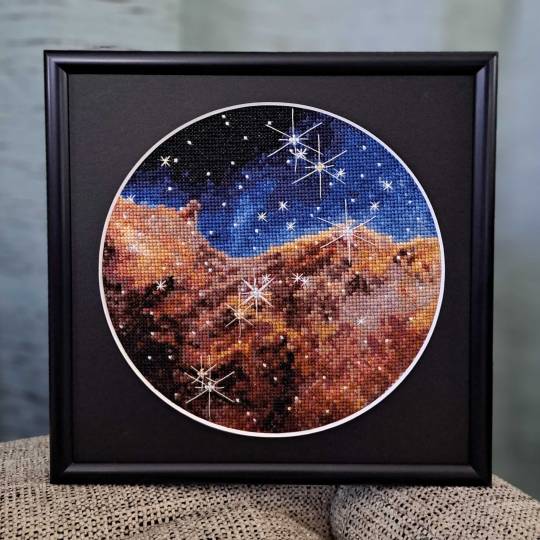
Wendy Edwards, a project coordinator with Earth Science Data Systems at NASA, created this embroidered piece inspired by Webb’s Carina Nebula image. Captured in infrared light, this image revealed for the first time previously invisible areas of star birth. Credit: Wendy Edwards, NASA. Pattern credit: Clare Bray, Climbing Goat Designs
Wendy Edwards, a project coordinator with Earth Science Data Systems at NASA, first learned cross stitch in middle school where she had to pick rotating electives and cross stitch/embroidery was one of the options. “When I look up to the stars and think about how incredibly, incomprehensibly big it is out there in the universe, I’m reminded that the universe isn’t ‘out there’ at all. We’re in it,” she said. Her latest piece focused on Webb’s image release of the Carina Nebula. The image showcased the telescope’s ability to peer through cosmic dust, shedding new light on how stars form.
Ocean Color Imagery: Exploring the North Caspian Sea

Danielle Currie of Satellite Stitches created a piece inspired by the Caspian Sea, taken by NASA’s ocean color satellites. Credit: Danielle Currie/Satellite Stitches
Danielle Currie is an environmental professional who resides in New Brunswick, Canada. She began embroidering at the beginning of the Covid-19 pandemic as a hobby to take her mind off the stress of the unknown. Danielle’s piece is titled “46.69, 50.43,” named after the coordinates of the area of the northern Caspian Sea captured by LandSat8 in 2019.

An image of the Caspian Sea captured by Landsat 8 in 2019. Credit: NASA
Two Hubble Images of the Pillars of Creation, 1995 and 2015
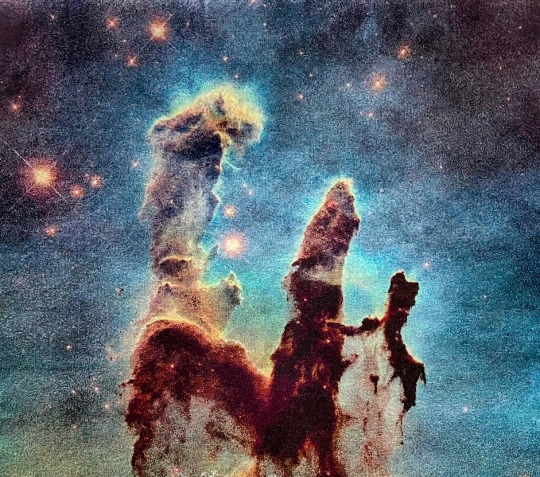
Melissa Cole of Star Stuff Stitching created an embroidery piece based on the Hubble image Pillars of Creation released in 1995. Credit: Melissa Cole, Star Stuff Stitching
Melissa Cole is an award-winning fiber artist from Philadelphia, PA, USA, inspired by the beauty and vastness of the universe. They began creating their own cross stitch patterns at 14, while living with their grandparents in rural Michigan, using colored pencils and graph paper. The Pillars of Creation (Eagle Nebula, M16), released by the Hubble Telescope in 1995 when Melissa was just 11 years old, captured the imagination of a young person in a rural, religious setting, with limited access to science education.
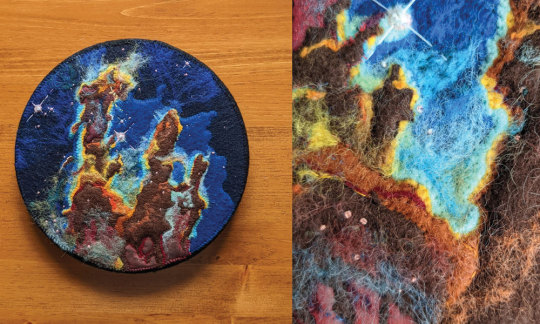
Lauren Wright Vartanian of the shop Neurons and Nebulas created this piece inspired by the Hubble Space Telescope’s 2015 25th anniversary re-capture of the Pillars of Creation. Credit: Lauren Wright Vartanian, Neurons and Nebulas
Lauren Wright Vartanian of Guelph, Ontario Canada considers herself a huge space nerd. She’s a multidisciplinary artist who took up hand sewing after the birth of her daughter. She’s currently working on the illustrations for a science themed alphabet book, made entirely out of textile art. It is being published by Firefly Books and comes out in the fall of 2024. Lauren said she was enamored by the original Pillars image released by Hubble in 1995. When Hubble released a higher resolution capture in 2015, she fell in love even further! This is her tribute to those well-known images.
James Webb Telescope Captures Pillars of Creation
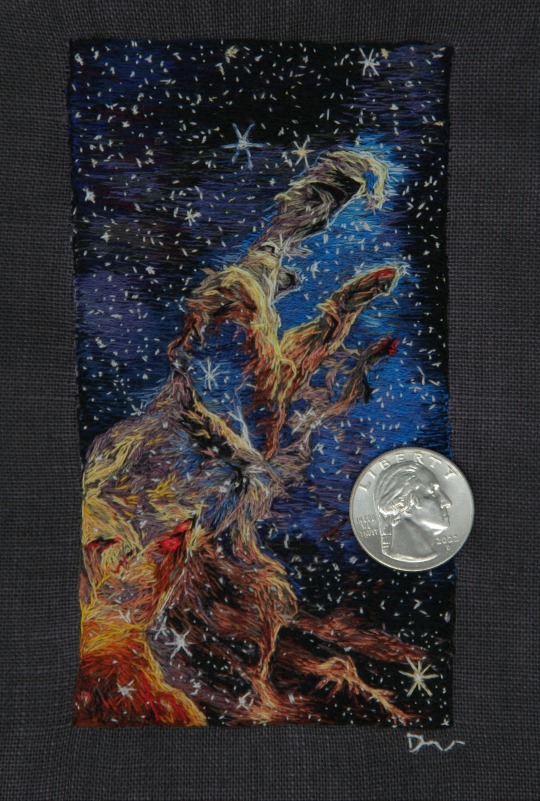
Darci Lenker of Darci Lenker Art, created a rectangular version of Webb’s Pillars of Creation. Credit: Darci Lenker of Darci Lenker Art
Darci Lenker of Norman, Oklahoma started embroidery in college more than 20 years ago, but mainly only used it as an embellishment for her other fiber works. In 2015, she started a daily embroidery project where she planned to do one one-inch circle of embroidery every day for a year. She did a collection of miniature thread painted galaxies and nebulas for Science Museum Oklahoma in 2019. Lenker said she had previously embroidered the Hubble Telescope��s image of Pillars of Creation and was excited to see the new Webb Telescope image of the same thing. Lenker could not wait to stitch the same piece with bolder, more vivid colors.
Milky Way
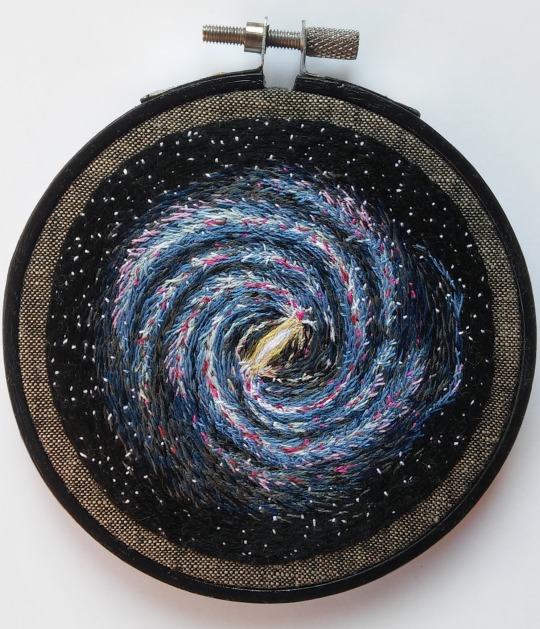
Darci Lenker of Darci Lenker Art was inspired by NASA’s imaging of the Milky Way Galaxy. Credit: Darci Lenker
In this piece, Lenker became inspired by the Milky Way Galaxy, which is organized into spiral arms of giant stars that illuminate interstellar gas and dust. The Sun is in a finger called the Orion Spur.
The Cosmic Microwave Background
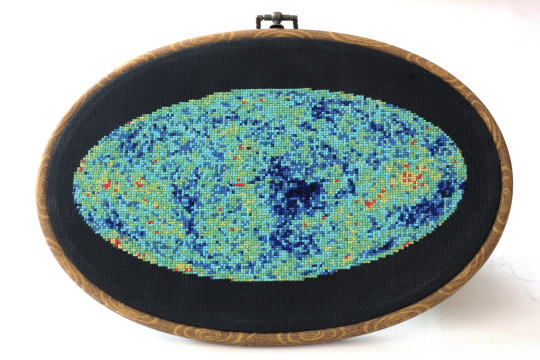
This image shows an embroidery design based on the cosmic microwave background, created by Jessica Campbell, who runs Astrostitches. Inside a tan wooden frame, a colorful oval is stitched onto a black background in shades of blue, green, yellow, and a little bit of red. Credit: Jessica Campbell/ Astrostitches
Jessica Campbell obtained her PhD in astrophysics from the University of Toronto studying interstellar dust and magnetic fields in the Milky Way Galaxy. Jessica promptly taught herself how to cross-stitch in March 2020 and has since enjoyed turning astronomical observations into realistic cross-stitches. Her piece was inspired by the cosmic microwave background, which displays the oldest light in the universe.

The full-sky image of the temperature fluctuations (shown as color differences) in the cosmic microwave background, made from nine years of WMAP observations. These are the seeds of galaxies, from a time when the universe was under 400,000 years old. Credit: NASA/WMAP Science Team
GISSTEMP: NASA’s Yearly Temperature Release
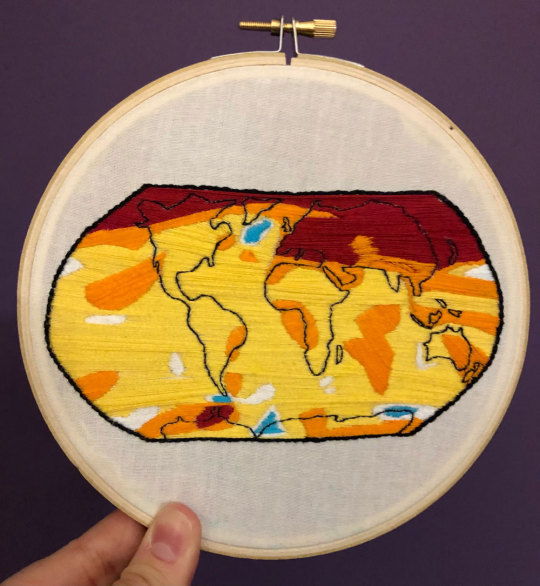
Katy Mersmann, a NASA social media specialist, created this embroidered piece based on NASA’s Goddard Institute for Space Studies (GISS) global annual temperature record. Earth’s average surface temperature in 2020 tied with 2016 as the warmest year on record. Credit: Katy Mersmann, NASA
Katy Mersmann is a social media specialist at NASA’s Goddard Space Flight Center in Greenbelt, Md. She started embroidering when she was in graduate school. Many of her pieces are inspired by her work as a communicator. With climate data in particular, she was inspired by the researchers who are doing the work to understand how the planet is changing. The GISTEMP piece above is based on a data visualization of 2020 global temperature anomalies, still currently tied for the warmest year on record.
In addition to embroidery, NASA continues to inspire art in all forms. Check out other creative takes with Landsat Crafts and the James Webb Space telescope public art gallery.
Make sure to follow us on Tumblr for your regular dose of space!
#NASA#creativity#fiber art#embroidery#art#art challenge#needlework#crafts#handmade#textile art#cross stitch#stitching#inspiration#inspo#Earth#Earth science#Hubble#James Webb Space Telescope#climate change#water#nebula#stars
6K notes
·
View notes
Text
Sandra Newman’s “Julia”

The first chapter of Orwell's Nineteen Eighty-Four has a fantastic joke that nearly everyone misses: when Julia, Winston Smith's love interest, is introduced, she has oily hands and a giant wrench, which she uses in her "mechanical job on one of the novel-writing machines":
https://gutenberg.net.au/ebooks01/0100021.txt
That line just kills me every time I re-read the book – Orwell, a novelist, writing a dystopian future in which novels are written by giant, clanking mechanisms. Later on, when Winston and Julia begin their illicit affair, we get more detail:
She could describe the whole process of composing a novel, from the general directive issued by the Planning Committee down to the final touching-up by the Rewrite Squad. But she was not interested in the finished product. She 'didn't much care for reading,' she said. Books were just a commodity that had to be produced, like jam or bootlaces.
I always assumed Orwell was subtweeting his publishers and editors here, and you can only imagine that the editor who asked Orwell to tweak the 1984 manuscript must have felt an uncomfortable parallel between their requests and the notional Planning Committee and Rewrite Squad at the Ministry of Truth.
I first read 1984 in the early winter of, well, 1984, when I was thirteen years old. I was on a family trip that included as visit to my relatives in Leningrad, and the novel made a significant impact on me. I immediately connected it to the canon of dystopian science fiction that I was already avidly consuming, and to the geopolitics of a world that seemed on the brink of nuclear devastation. I also connected it to my own hopes for the nascent field of personal computing, which I'd gotten an early start on, when my father – then a computer science student – started bringing home dumb terminals and acoustic couplers from his university in the mid-1970s. Orwell crystallized my nascent horror at the oppressive uses of technology (such as the automated Mutually Assured Destruction nuclear systems that haunted my nightmares) and my dreams of the better worlds we could have with computers.
It's not an overstatement to say that the rest of my life has been about this tension. It's no coincidence that I wrote a series of "Little Brother" novels whose protagonist calls himself w1n5t0n:
https://craphound.com/littlebrother/Cory_Doctorow_-_Little_Brother.htm
I didn't stop with Orwell, of course. I wrote a whole series of widely read, award-winning stories with the same titles as famous sf tales, starting with "Anda's Game" ("Ender's Game"):
https://www.salon.com/2004/11/15/andas_game/
And "I, Robot":
https://craphound.com/overclocked/Cory_Doctorow_-_Overclocked_-_I_Robot.html
"The Martian Chronicles":
https://escapepod.org/2019/10/03/escape-pod-700-martian-chronicles-part-1/
"True Names":
https://archive.org/details/TrueNames
"The Man Who Sold the Moon":
https://memex.craphound.com/2015/05/22/the-man-who-sold-the-moon/
and "The Brave Little Toaster":
https://archive.org/details/Cory_Doctorow_Podcast_212
Writing stories about other stories that you hate or love or just can't get out of your head is a very old and important literary tradition. As EL Doctorow (no relation) writes in his essay "Genesis," the Hebrews stole their Genesis story from the Babylonians, rewriting it to their specifications:
https://www.penguinrandomhouse.com/books/41520/creationists-by-e-l-doctorow/
As my "famous title" stories and Little Brother books show, this work needn't be confined to antiquity. Modern copyright may be draconian, but it contains exceptions ("fair use" in the US, "fair dealing" in many other places) that allow for this kind of creative reworking. One of the most important fair use cases concerns The Wind Done Gone, Alice Randall's 2001 retelling of Margaret Mitchell's Gone With the Wind from the perspective of the enslaved characters, which was judged to be fair use after Mitchell's heirs tried to censor the book:
https://en.wikipedia.org/wiki/Suntrust_Bank_v._Houghton_Mifflin_Co.
In ruling for Randall, the Eleventh Circuit Court of Appeals emphasized that she had "fully employed those conscripted elements from Gone With the Wind to make war against it." Randall used several of Mitchell's most famous lines, "but vest[ed] them with a completely new significance":
https://law.justia.com/cases/federal/appellate-courts/F3/268/1257/608446/
The Wind Done Gone is an excellent book, and both its text and its legal controversy kept springing to mind as I read Sandra Newman's wonderful novel Julia, which retells 1984 from the perspective of Julia, she of the oily hands the novel-writing machine:
https://www.harpercollins.com/products/julia-sandra-newman?variant=41467936636962
Julia is the kind of fanfic that I love, in the tradition of both Wind Done gone and Rosenkrantz and Gildenstern Are Dead, in which a follow-on author takes on the original author's throwaway world-building with deadly seriousness, elucidating the weird implications and buried subtexts of all the stuff and people moving around in the wings and background of the original.
For Newman, the starting point here is Julia, an enigmatic lover who comes to Winston with all kinds of rebellious secrets – tradecraft for planning and executing dirty little assignations and acquiring black market goods. Julia embodies a common contradiction in the depiction of young women (she is some twenty years younger than Winston): on the one hand, she is a "native" of the world, while Winston is a late arrival, carrying around all his "oldthink" baggage that leaves him perennially baffled, terrified and angry; on the other hand, she's a naive "girl," who "doesn't much care for reading," and lacks the intellectual curiosity that propels Winston through the text.
This contradiction is the cleavage line that Newman drives her chisel into, fracturing Orwell's world in useful, fascinating, engrossing ways. For Winston, the world of 1984 is totalitarian: the Party knows all, controls all and misses nothing. To merely think a disloyal thought is to be doomed, because the omnipotent, omniscient, and omnicompetent Party will sense the thought and mark you for torture and "vaporization."
Orwell's readers experience all of 1984 through Winston's eyes and are encouraged to trust his assessment of his situation. But Newman brings in a second point of view, that of Julia, who is indeed far more worldly than Winston. But that's not because she's younger than him – it's because she's more provincial. Julia, we learn, grew up outside of the Home Counties, where the revolution was incomplete and where dissidents – like her parents – were sent into exile. Julia has experienced the periphery of the Party's power, the places where it is frayed and incomplete. For Julia, the Party may be ruthless and powerful, but it's hardly omnicompetent. Indeed, it's rather fumbling.
Which makes sense. After all, if we take Winston at his word and assume that every disloyal citizen of Oceania is arrested, tortured and murdered, where would that leave Oceania? Even Kim Jong Un can't murder everyone who hates him, or he'd get awfully lonely, and then awfully hungry.
Through Julia's eyes, we experience Oceania as a paranoid autocracy, corrupt and twitchy. We witness the obvious corollary of a culture of denunciation and arrest: the ruling Party of such an institution must be riddled with internecine struggle and backstabbing, to the point of paralyzed dysfunction. The Orwellian trick of switching from being at war with Eastasia to Eurasia and back again is actually driven by real military setbacks – not just faked battles designed to stir up patriotic fervor. The Party doesn't merely claim to be under assault from internal and external enemies – it actually is.
Julia is also perfectly positioned to uncover the vast blank spots in Winston's supposed intellectual curiosity, all the questions he doesn't ask – about her, about the Party, and about the world. I love this trope and used it myself, in Attack Surface, the third "Little Brother" book, which is told from the point of view of Marcus's frenemy Masha:
https://us.macmillan.com/books/9781250757531/attacksurface
Through Julia, we come to understand the seemingly omniscient, omnipotent Party as fumbling sadists. The Thought Police are like MI5, an Island of Misfit Toys where the paranoid, the stupid, the vicious and the thuggish come together to ruin the lives of thousands, in such a chaotic and pointless manner that their victims find themselves spinning devastatingly clever explanations for their behavior:
https://www.bbc.co.uk/blogs/adamcurtis/entries/3662a707-0af9-3149-963f-47bea720b460
And, as with Nineteen Eighty-Four, Julia is a first-rate novel, expertly plotted, with fantastic, nail-biting suspense and many smart turns and clever phrases. Newman is doing Orwell, and, at times, outdoing him. In her hands, Orwell – like Winston – is revealed as a kind of overly credulous romantic who can't believe that anyone as obviously stupid and deranged as the state's representatives could be kicking his ass so very thoroughly.
This was, in many ways, the defining trauma and problem of Orwell's life, from his origin story, in which he is shot through the throat by a fascist: sniper during the Spanish Civil War:
https://www.rjgeib.com/thoughts/soldiers/george-orwell-shot.html
To his final days, when he developed a foolish crush on a British state spy and tried to impress her by turning his erstwhile comrades in to her:
https://en.wikipedia.org/wiki/Orwell%27s_list
Newman's feminist retelling of Orwell is as much about puncturing the myth of male competence as it is about revealing the inner life, agency, and personhood of swooning love-interests. As someone who loves Orwell – but not unconditionally – I was moved, impressed, and delighted by Julia.

Tor Books as just published two new, free LITTLE BROTHER stories: VIGILANT, about creepy surveillance in distance education; and SPILL, about oil pipelines and indigenous landback.
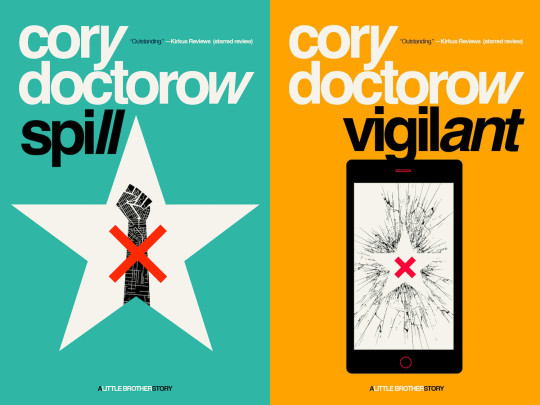

If you'd like an essay-formatted version of this post to read or share, here's a link to it on pluralistic.net, my surveillance-free, ad-free, tracker-free blog:
https://pluralistic.net/2024/09/28/novel-writing-machines/#fanfic
#pluralistic#reviews#books#orwell#george orwell#nineteen eighty-four#1984#little brother#fanfic#remix#gift guide#science fiction#sandra newman
704 notes
·
View notes
Text
The Good Omens Musical Masterpost🎵❤
How it started :)
Some time before 2013: Vicki Larnach, the australian composer and lyricist, read the Good Omens book, imagined figures dancing on stage with brilliant music and thought, ‘Ah, I’m gonna ask Terry Pratchet and Neil Gaiman if I can turn it into a musical.’ and sent an email to the publishers. The next day she got an email saying, ‘We don’t want a musical but Terry’s coming to Australia, so come and say hello and tell us what you got.’
Rob Wilkins came down to meet Vicki and Jim Hare - Vicki's husband and writer - and took them to meet Terry. They spent an hour and a half with them where Terry asked ‘piercing questions’, had tea with them and they showed Terry a song that Vicki wrote (about the Chattering Nuns). Terry said to Rob, ‘Rob, write and email to Neil, “Dear Neil, this is Terry. I’m sitting in front of two hippies from Sydney and they want to make a musical out of Good Omens and I’m tempted to let them do it.”’ which was the best email they ever heard and then Terry said, ‘Okay, you have me curious.’ - it was because of the Nuns song which sounded like the book. ‘I’m gonna give you six months, come back with a first draft libretto and five songs.’
They then sent it to Terry who sent it to Gaiman. Terry said, ‘I really like it, you’re moving story, you’re doing all the right things, but where’s showstopper, where’s the toe-tapper, you know I need people to go to intermission just snapping their fingers with the song they just can’t get out of their head, and I haven’t heard that.’ - and they realized that they were so busy serving the story they forgot to do the wow-factor, but found it very encouraging from Terry that he wanted to make it better.
They went through the whole book again to find a centrepiece - and they found it when Warlock is growing up and Aziraphale and Crowley are with him, and spent months working just on that one thing and called ‘All Living Things’ [the song at the start of this post :)] which is a line from the book.*’ Terry gave that song to a person he knew and asked him to play it to his wife with no context and when the next day the person said that his wife woke up still singing the song Terry said to Vicki and Jim: ‘Well, that’s what I asked you to do.’
* [“This here’s Brother Slug,” the gardener would tell him, “and this tiny little critter is Sister Potato Weevil. Remember, Warlock, as you walk your way through the highways and byways of life’s rich and fulsome path, to have love and reverence for all living things.” “Nanny says that wivving fings is fit onwy to be gwound under my heels, Mr. Fwancis,” said little Warlock, stroking Brother Slug, and then wiping his hand conscientiously on his Kermit the Frog overall.]
Vicki and Jim got the permission to being adapting it as a musical in 2013.
Vicki and Jim on it a couple of years ‘fumbling about’, took it as far as they could and decided to bring another person into it: Jay-James Moody
In 2015, Jay James-Moody joined the collaboration initially as a dramaturge and directorial eye, eventually evolving into co-book writer. Vicki, James and Jay have continued to evolve through countless more revisions and a number of private development readings with the support, time and talent of numerous wonderful Australian performers testing the material.
In November 2017, the musical was presented in its then-current form and entirety for the first time before an audience of over 500 eager attendees. The cast included Luke Joslin, Lachlan O’Brien, Nancye Hayes, Barry Quin, Brett O’Neill, Lauren McKenna, Nicholas Craddock, Paul Capsis, Rob Johnson, Amy Lehpamer, Debora Krizak, Blake Erickson, Nat Jobe, Ana Maria Belo, Jordan Hare, Bella Thomas, Anthony Abrakmanov and Samson Hyland.
Following a rapturous response to this reading it continued to be refined and developed.
In 2019, ten days before the show came out they did their last presentation, since then they’ve been to London and shown a videotape of that workshop to Gaiman and Rob Wilkins which was ‘a pretty heartstopping experience’.
Differences between the musical and the book
The ending of the musical is a bit different.
It opens with the burning of Agnes Nutter and Aziraphale and Crowley are introduced there.
Act One ends with them ‘essentially breaking up’ because of a huge argument and they dissolve their friendship, Act Two starts with the first time they meet.
The Future?
What is the future for the musical: in 2021 they said that they need to work on some things and then they hope to do another run, initially in Australia.
There will be a CD of the soundtrack available when the show is produced in it’s full version.
In 2024 on insta they said that it is in "complicated process of rights to stage Good Omens" and "We appreciate your support and patience of the progress or seeming lack therof, of Good Omens the musical but we assure you, we will bring you the show in the next few years."
Videos
Vicki, Jim and Jay talking 46min about the musical (this video was shown at the Ineffable Con 3 in 2021 :))
Sizzle Reel 6min
Anathema singing The Perfect Place
Crowley calling Dagon to check on the hellhound
Shadwell and Newt
Aziraphale vanishing Hastur 👀
Links
Webpage
Instagram - a lot of more bts videos and pics :)
How to support?
Subsribe to the instagram page and like and comment that you want the musical on posts :)❤. If you want to be a sponsor or donor, there is contact on their webpage.

2K notes
·
View notes
Note
Do you have a list of good sex ed books to read?
BOY DO I
please bear in mind that some of these books are a little old (10+ years) by research standards now, and that even the newer ones are all flawed in some way. the thing about research on human beings, and especially research on something as nebulous and huge as sex, is that people are Always going to miss something or fail to account for every possible experience, and that's just something that we have to accept in good faith. I think all of these books have something interesting to say, but that doesn't mean any of them are the only book you'll ever need.
related to that: it's been A While since I've read some of these so sorry if anything in them has aged poorly (I don't THINK SO but like, I was not as discerning a reader when I was 19) but I am still including them as books that have been important to my personal journey as a sex educator.
additionally, a caveat that very few of these books are, like, instructional sex ed books in the sense of like "here's how the penis works, here's where the clit is, etc." those books exist and they're great but they're also not very interesting to me; my studies on sex are much more in the social aspect (shout out to my sociology degree) and the way people learn to think about sex and societal factors that shape those trends. these books reflect that. I would genuinely love to have the time to check out some 101 books to see how they fare, but alas - sex ed is not my day job and I don't have the time to dedicate to that, so it happens slowly when it happens at all. I've been meaning to read Dr. Gunter's Vagina Bible since it came out in 2019, for fucks sake.
and finally an acknowledgement that this is a fairly white list, which has as much to do with biases with academia and publishing as my own unchecked biases especially early in my academic career and the limitations of my university library.
ANYWAY here's some books about sex that have been influential/informative to me in one way or another:
The Trouble With Normal: Sex, Politics, and the Ethics of Queer Life (Michael Warner, 1999)
Virginity Lost: An Intimate Portrait of First Sexual Experiences (Laura M. Carpenter, 2005)
Virgin: The Untouched History (Hanne Blank, 2007)
Sex Goes to School: Girls and Sex Education Before the 1960s (Susan K. Freeman, 2008)
Bonk: The Curious Coupling of Science and Sex (Mary Roach, 2008)
Transgender History: The Roots of Today's Revolution (Revised Edition) (Susan Stryker, 2008)
The Purity Myth: How America's Obsession with Virginity is Hurting Young Women (Jessica Valenti, 2009)
Not Under My Roof: Parents, Teens, and the Culture of Sex (Amy T. Schalet, 2011)
Straight: The Surprisingly Short History of Heterosexuality (Hanne Blank, 2012)
Rewriting the Rules: An Integrative Guide to Love, Sex and Relationships (Meg-John Barker, 2013)
The Sex Myth: The Gap Between Our Fantasies and Realities (Rachel Hills, 2015)
Come as You Are: The Surprising New Science That Will Tranform Your Sex Life (Emily Nagoski, 2015)
Not Gay: Sex Between Straight White Men (Jane Ward, 2015)
Too Hot to Handle: A Global History of Sex Education (Jonathan Zimmerman, 2015)
American Hookup: The New Culture of Sex on Campus (Lisa Wade, 2017)
Buzz: A Stimulating History of the Sex Toy (Hallie Lieberman, 2017)
Histories of the Transgender Child (Jules Gill-Peterson, 2018)
Revolting Prostitutes: The Fight for Sex Workers' Rights (Juno Mac and Molly Smith, 2018)
Ace: What Asexuality Reveals About Desire, Society, and the Meaning of Sex (Angela Chen, 2020)
Pleasure in the News: African American Readership and Sexuality in the Black Press (Kim Gallon, 2020)
A Curious History of Sex (Kate Lister, 2020)
Boys & Sex: Young Men on Hookups, Love, Porn, Consent, and Navigating the New Masculinity (Peggy Orenstein, 2020)
Black Women, Black Love: America's War on Africa American Marriage (Dianne M. Stewart, 2020)
The Tragedy of Heterosexuality (Jane Ward, 2020)
Hurts So Good: The Science and Pleasure of Pain on Purpose (Leigh Cowart, 2021)
Strange Bedfellows: Adventures in the Science, History, and Surprising Secrets of STDs (Ina Park, 2021)
The Right to Sex: Feminist in the Twenty-First Century (Amia Srinivasan, 2021)
Love Your Asian Body: AIDS Activism in Los Angeles (Eric C. Wat, 2021)
Superfreaks: Kink, Pleasure, and the Pursuit of Happiness (Arielle Greenberg, 2023)
869 notes
·
View notes
Text
after my nigh twenty years of chewing on this series, i think the key to making any asoiaf prediction is to remember that george rr martin doesn’t consider anything to be set in stone until it is published. that man will change his mind on a dime. he will change course, he will add povs. he will drop time jumps. he will retcon. i don’t care what groundwork he’s laid. i don’t care what he’s sworn he will or won’t do. there are no guard rails with him. none
i promise you his ending is not the same now as it was in 2019 as it was in 2015 as it was in 2013 as it was in 2011 as it was in 2006 as it was in 2003 as it was in 1999 as it was in 1997 as it was in 1995 as it was in 1993
it’s in flux. it’s schrodinger’s endgame. even he won’t know what’s in that damn box until he opens it. as of this moment anything is possible
#asoiaf#asoiaf predictions are like watsonsonian asoiaf prophecies#don’t fuck with them if you want to keep your genitals intact
239 notes
·
View notes
Text
Nature and Nurture
Authour: @lurkinglurkerwholurks
Subfandom: Batman
Media: Comics
Relationships: Gen (Bruce Wayne-centric)
Year: 2018
Summary:
It was a no good, very bad night all around, and it kept getting worse. In which the writer explores some classic tropes, indulges in some BatFam feels, and explores the effects of nature and nurture on the psyche of one Bruce Thomas Wayne.
Submitted by @Sanetona
Originally was intrigued at the 'de-aging but not the cutesy kind' tags, this fic was a really cool exploration of Bruce Wayne's character over time, how who he was leads us to who he is. Different batkids bonding with different versions of Bruce, different facets of who he was once, made for a super interesting read. This fic also tackles some of the mis-steps of one Alfred Pennyworth, trying his best but not some magically all knowing grandfatherly figure, and that really let him be a character instead of a caricature. Extremely enjoyable read that lives somewhere under my collarbone and has for over a year now
#batman#published: 2015 to 2019#media: comics#gen#DC fic recs#lurkinglurkerwholurks#ooh more lurker representation!#wonderful!
22 notes
·
View notes
Text
The 4B Movement: How South Korean women are leaving the patriarchy behind
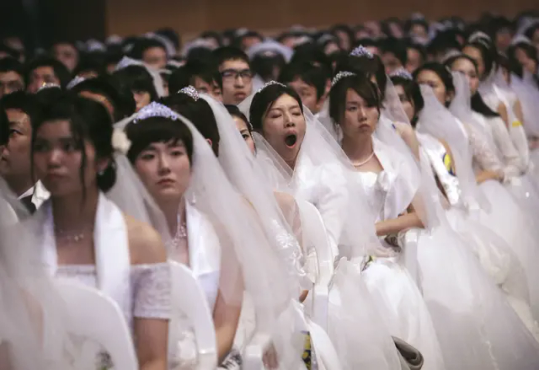
(Getty Images)
In 2016, a 34-year-old man named Kim Sung-min waited inside a unisex restroom outside exit 10 of Gangnam Station, Seoul South Korea. Six different men came and exited through the restroom over the span of an hour, until a 23-year-old woman entered, and Kim proceeded to stab and kill her with a 12-inch-long sushi knife. In court, Kim stated, “I did it because women have always ignored me.” Kim’s actions and thoughts are not out of the ordinary amongst Korean men—violence against women is extremely common in South Korea.
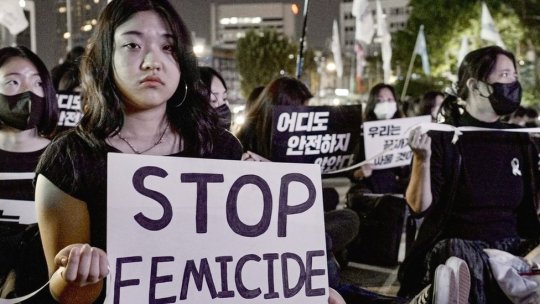
(BBC)
South Korea has a long record of female subjugation. Between 1953 and 2021, abortion was illegal in almost all circumstances, and current law allows a woman to get an abortion only if she has consent from a male relative or her boyfriend/husband/partner. A 2015 South Korean government survey revealed that almost 80% of women had been sexually harassed at work. A survey released by The Ministry of Gender Equality and Family found that 57.8 percent of women felt vulnerable to misogynistic violence. Digital crime and sexual harassment are extremely common— “molka”, up-skirt photos, and secret cameras hidden in restrooms are rampant, so much so that any cellphone purchased in South Korea has a mandatory chime when photos are taken. The World Economic Forum’s 2022 Global Gender Gap Index ranks South Korea at number 99 out of 146 countries for gender equality. Legislation actively works against women trying to report sexual assault. Men accused of stalking or harassment can “ask” their victims to drop charges, and in 2022 a man murdered his former colleague after she refused to drop charges against him for stalking her since 2019. South Korea has the highest gender pay gap of all the OECD countries—the top wealthiest 37 countries, globally, with women earning on average a third less than men. These alarming statistics have come years after the “Gangnam Station” murder, and South Korean women continue to be targeted for their gender.
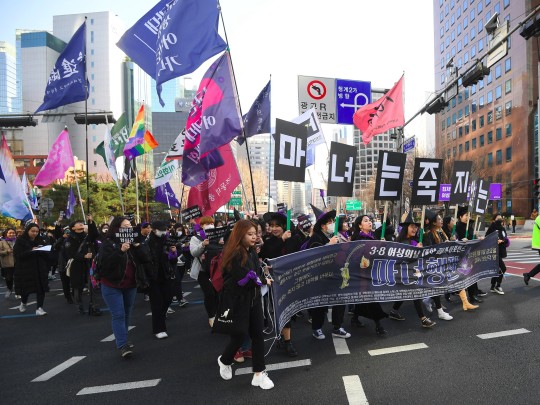
(Jung Yeon-Je/AFP via Getty Images)
Despite Kim’s own testimony, government authorities explicitly denied the misogynistic motive, and the prosecution announced that the case was not being investigated as a hate crime. Kim was eventually sentenced to 30 years in prison. In response to the murder, women took to the streets outside Gangnam station and the surrounding areas in protest. The women, many of whom had never considered themselves feminists or activists, but the nature of the crime and the misogynistic motivation, as well as the court's refusal to acknowledge it, outranged them. The murder incited intense debates about misogyny within the country, and the gender inequities women faced both socially and economically. Five months after the murder, Cho Nam-Joo’s novel Kim Jiyoung, Born 1982 was published. The book devastatingly details an everyday woman’s daily experiences of nonstop sexism, inequality, and misogyny in contemporary South Korea, and served as another enraging eye-opener that would develop into what would become known as the 4B Movement.
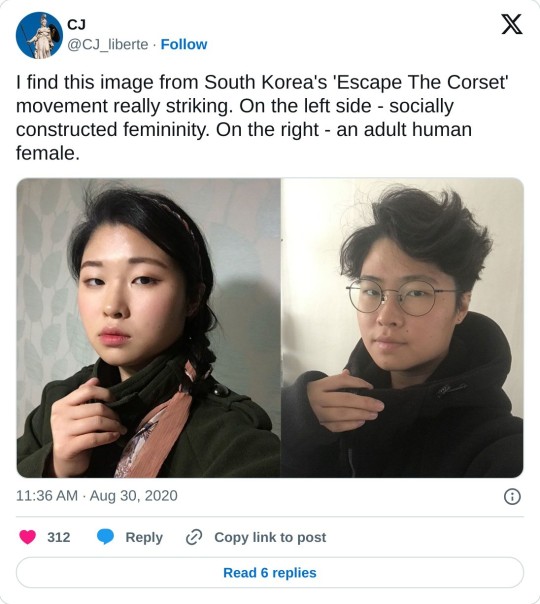
The four B’s (or “Four No’s”) of the movement represent the four major components that women of the movement are rejecting; Bisekseu (sex), Bichulsan (child-bearing), Biyeonae, (dating) and Bihon (marriage). South Korean feminists define the 4B movement not as a fight against the patriarchy, but a complete step away from it— leaving it behind. In 2017, the Escape the Corset campaign swept across the country. The word “corset” is used by Korean feminists as a metaphor for the societal mechanisms that control and repress women, for example, the extreme and toxic beauty standards. Both 4B and Escape the Corset condemn and reject the influence that beauty holds within every aspect of South Korean life. Pioneers such as feminist author Cho Nam-Joo, and photographer Jeon Bo-ra, who photographed women who shaved their heads in rebellion. Social media has played a large role in the 4B movement, with bloggers and beauty influencers like Lina Bae speaking up against unattainable beauty standards and societal pressures, and Summer Lee who was inspired to cut her hair, throw away her hyperfeminine clothes, and post pictures of herself without makeup.
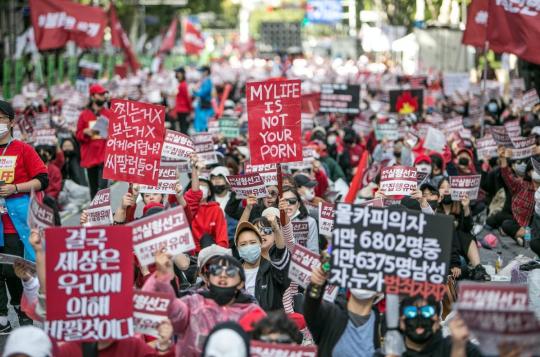
(Jean Chung/Getty Images)
Despite increasing conversation on women’s rights, feminism is still considered a taboo, contentious, or even “dirty” word for many South Koreans. It is often associated with “man-hating” and perceived as overly aggressive. The country's current president Yoon Suk-yeol has promised to close down the South Korean Ministry of Gender Equility and Family, and any other organizations that fund or support women and victims of sexual violence, claiming they “treat men like potential sex criminals”. A January 2023 article in the South Korean newspaper The Sisa Times reported that 65% of women in the country do not want children, 42% do not want to get married, and over 80% of those cite domestic violence as their key reason. As a result, concerns regarding the rising average population age and declining birth rate in South Korea have increased greatly. The country's birth rate is less than one per woman as of 2021, and the country saw less than 200,000 marriages. In recent years, the South Korean government has commissioned a number of soap operas and reality TV shows to promote an idyllic view of romantic heterosexual love, and to encourage marriage and reproduction.

(Yonhap)
The 4B movement and Escape the Corset campaign have had a tremendous impact on the way young South Korean women view the countries cultural grip on women’s appearances and lives. Between 2015-2016 and 2017-2018, Korean women spent over 5 billion Korean Won less on beauty products and cosmetic surgeries, instead investing their money in cars and choosing independence over objectification. The movement is calling for boycotts of any business that uses sexist advertising, and encouraging women to eat at women-owned restaurants, drink in women-owned bars, and shop at women-owned stores—women’s money goes into the pockets of other women. Women’s universities have also been on the rise in South Korea, with most cities housing one or several women-only institutions. Similarly, women’s only spaces have begun to expand, women’s parking spots closer to entrances and exits in parking garages, women’s only hotel floors and common rooms, and women’s only subway cars. These spaces allow feminism to spread and flourish, and give Korean women the ability to find community with other women without the interference of men.
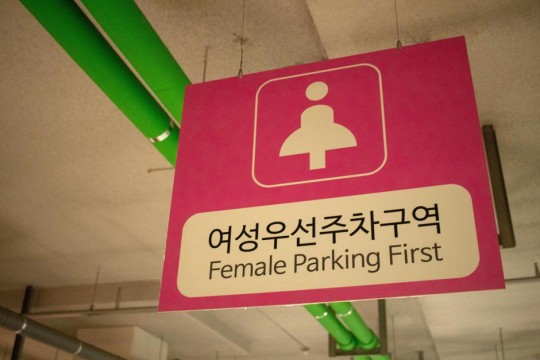
(Ian Baldessari/CityLab)
Since 2016, Exit 10 of Gangnam Station has become a symbolic site for South Korean feminism. The South Korean feminist movement developed out of particularly misogynist conditions within their country. The 4B movement represents a radical way that women have sought to create an online and offline world devoid of men—rather than engaging in arguments and altercations, they simply refuse to interact with men in every aspect of their lives. These actions have had a profound impact on the functionality of South Korean society and have opened an uncloseable door too the discussion of women’s rights.
McCurry, Justin. “Calls for Stalking Law Overhaul in South Korea as Woman’s Murder Shocks Nation.” The Guardian, Guardian News and Media, 23 Sept. 2022, www.theguardian.com/world/2022/sep/23/calls-for-stalking-law-overhaul-in-south-korea-as-womans-shocks-nation.
Teehan, Katie. “What Is the 4B Movement?” Service95, 16 Apr. 2024, www.service95.com/4b-movement-explainer/.
Izaakson , Jen, and Tae Kyung Kim. “The South Korean Women’s Movement: ‘We Are Not Flowers, We Are a Fire.’” Feminist Current, 16 June 2020, www.feministcurrent.com/2020/06/15/the-south-korean-womens-movement-we-are-not-flowers-we-are-a-fire/.
Lee, Min Joo. “Why so Many South Korean Women Are Refusing to Date, Marry or Have Kids.” Yahoo! News, Yahoo!, 15 May 2023, news.yahoo.com/why-many-south-korean-women-123250959.html?guccounter=1&guce_referrer=aHR0cHM6Ly93d3cuZ29vZ2xlLmNvbS8&guce_referrer_sig=AQAAAHmBVorK4v6bdzwcJMRyRdXkKtzUlpQYWn5Ot-BPzs-YRNNZFW5JBwC65OTaPrRImn3F3G56r0gfNydadUzlQtPS61hOi6uggk_OkwZqqvLvS-YN4HbPrpwKvK9_7g0e9yqu9fiRRvOVJkGRv__L7AZGoYtfHVxjKLLPDi9DI2fu.
Park, Seohoi Stephanie. “Murder at Gangnam Station: A Year Later.” KOREA EXPOSÉ, 2 Mar. 2023, koreaexpose.com/murder-gangnam-station-year-later/.
Dockeray, Hannah. “Why Some South Korean Women Are Rejecting Beauty.” Sky News, 14 July 2021, news.sky.com/story/plastic-surgery-south-korea-faces-beauty-backlash-11871654.
808 notes
·
View notes
Text
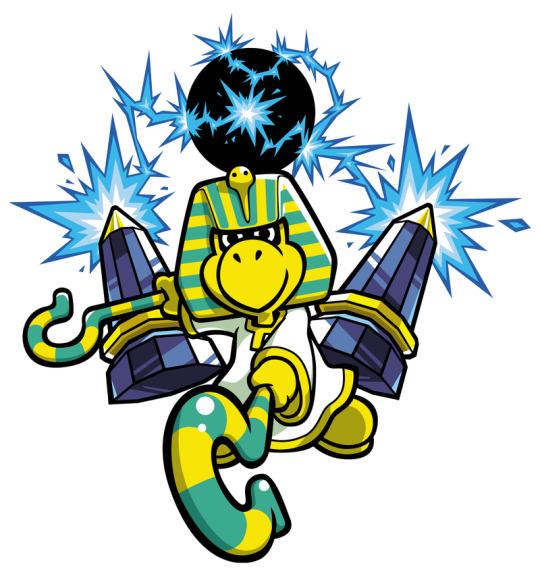
ok here's my timeline of egyptian koopa/king tut Notable Events, mostly to sate my own desire for one
AUG 2000: paper mario is released for the n64, debuting the character tutankoopa
SEPT 2002: adrian barritt & richard horrocks found fuse games (later renamed silverball studios)--not long thereafter, they pitch mario pinball land (aka super mario ball) to nintendo and are greenlit (source)
AUG 2004: mario pinball land launches in japan, followed by an autumn release elsewhere. the boss of its desert world--a pharaoh-themed koopa (video)--goes unnamed in the game. a page (author uncredited) on the official japanese promo guide site for pinball land calls it ボスノコノコ ("boss nokonoko", i.e. "boss koopa"--this follows a similar convention to the jp names for big bully, sunshine's wiggler, petey piranha, & others)

SEPT 2004: a walkthrough on gamefaqs by user qqwref refers to that boss as "tutankoopa"--afaict this is the first time anyone has publicly referred to this character by any name in english!
OCT 2004: a japanese licensed guidebook published by shogakukan (akiharu tsuchida et al) uses the name ファラオノコノコ ("pharaoh nokonoko", thus "pharaoh koopa"). everyone say thank you mariowiki for cataloguing the image. (i verified the book's release date via the final photo on this sale listing)

NOV 2004: nintendo power issue 185 features a mario pinball land guide (author uncredited, probably one of the names on this page) which refers to the boss as "egyptian koopa". note also the "piranha pete" error on the same page & the "spikey" error on the preceding page. the same month, a gamefaqs guide calls the boss "pharoe (sic) koopa troopa"
DEC 2004: (possibly earlier?) the american & australian mario pinball land promo flash pages (author uncredited) feature a(n unpreserved) video titled "king tut", presumably in reference to this boss:
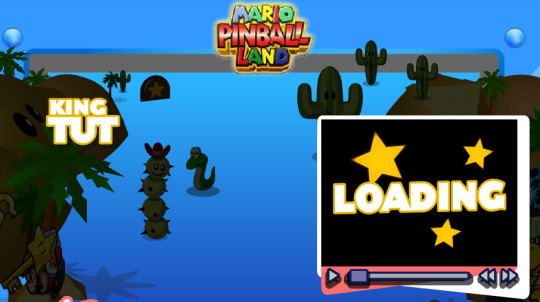
JUL 2006: tutankoopa's mariowiki.com page is updated to add the claim that he is the boss in pinball land
AUG 2006: the first version of mario pinball land's mariowiki page calls the boss "tutankoopa"
some time before MAR 2007: the mario characters guide on gamefaqs by user spacepope4u conflates tutankoopa with the pinball land boss. sadly the version history is not very robust so i can't verify when this was added. references to the "egyptian koopa" name from np are also included:

MAY 2007: the first version of the boss's mariowiki page is created under the name "king tut" (probably taking the name from the site above, albeit without citing it). a revision the following day adds the name "koop tut" as well. around the same time, conflation of "king tut" with tutankoopa is removed from both the tutankoopa page and the pinball land page. the "king tut" name begins to gain traction
FEB 2008: "koop tut" is removed from the mariowiki page
DEC 2009: on the wiki's talk page two users very briefly discuss whether this character should be considered the same as tutankoopa
2012: silverball studios is bought by barnstorm games (source). not really relevant but i thought it was interesting
APR 2015: a "citation needed" template is added to the "king tut" page
NOV 2015: a thread is created on super mario boards to discuss the "king tut" name situation. the name of the wiki page is changed to "egyptian koopa", following the nintendo power name above. that name proliferates on other platforms, such as this beautiful forum thread:

SEPT 2019: a singular japanese deviantart user uploads fanart & refers to this character in the caption as ボスカメック ("boss kamek", thus "boss magikoopa"--notably, this is the jp name for kamella) as far as i can tell, literally nobody else has ever used this name for this character
OCT 2023: i post a video on the subject. lol
NOV 2023: warioware: move it is released: a microgame in 9-volt's stage, "mario pinball land", features an appearance by "egyptian koopa" (video). it continues to go unnamed
JUN 2025: the flash site from 2004 is rediscovered by mariowiki users: the page is renamed back to king tut in accordance with this new information
to recap the names that have been used, in the order of first extant public usage:
boss koopa (ボスノコノコ): comes from the official japanese guide site in 2004. a cursory search suggests that it's the most common name used on the japanese web (ex: pixiv, nintendo wiki, niconico, wikipedia, twitter)
tutankoopa: unofficial conflation of this boss with the paper mario character. earliest known recorded use is in the 2004 gamefaqs guide above. what the boss was called on mariowiki from 2006 to 2007. a variety of other sources have (possibly independently) furthered this conflation (ex: youtube (1, 2, 3), khinsider, gamefaqs (1, 2, forum), lemmy's land)
pharaoh koopa (ファラオノコノコ): comes from the licensed japanese shogakukan guidebook in 2004. appears in some of the "boss koopa" sources above, but only as a parenthetical. used only once in english in a fan guide, probably without referent
egyptian koopa: officially printed in nintendo power in 2004, used as the primary name on mariowiki from 2015 to 2025. widely used on the english web (ex: youtube (1, 2, 3, 4), deviantart, fandom.com, spriters resource, tvtropes)
king tut: featured on the official flash promo site in 2004. the name on mariowiki from 2007 to 2015, and again as of june 2025. can be seen online in some sources from 2015 and earlier (ex. fantendo, giantbomb, blogspot, datacrystal, youtube)
koop tut: unofficial, appeared in the body of the mariowiki page from 2007 to 2008. may have been pulled from a super show episode. not used anywhere else afaict
boss magikoopa (ボスカメック): unofficial, used by a single deviantart user in 2019
68 notes
·
View notes
Text
The untitled album turns 6 today 🎶💿
On this day in 2019, Rammstein released their seventh studio album. What was significant and different compared to previous albums was that this one had no written title on the cover—just an image of a matchstick. As a result, it came to be known as the “untitled” or “matchstick” album.
Richard's recurring statement in past interviews that no new album was planned is widely known. After the LIFAD tour ended in 2013, the band took a year off, and after one more meeting, another year. The general consensus was that they didn’t want to pressure themselves or each other, since the working phase for the LIFAD album had been very exhausting in terms of group dynamics. In an interview in 2015, Till revealed that the band would be meeting in September 2015 for a casual, creative gathering. In October 2015, this photo was published on the official website, showing the band improvising in Schneider’s studio:
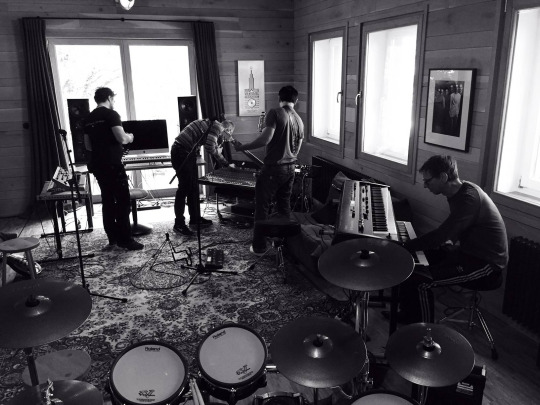
It was decided that the band would work between the festival tours of 2016 and 2017, and that rest periods should be respected. Richard worked on his demos together with Till; the final results were presented to the rest of the band during their meetings and discussed.
As the first result of that creative period, the song 'Ramm4' was introduced during the 2016 tour. Flake commented: “We wanted to show the world that we are still together and that we are creating new music.” To this day, the song hasn’t been officially released, although it was used again as the opening song on last year’s tour.
At the end of 2016, work resumed. In March 2017, Richard mentioned in this interview for the Rammstein in Paris film that at that point, 35 almost-finished songs existed, and that the wait would be worth it. Over the course of the year, these drafts were reduced to 28. Sky van Hoff also mentioned that same year that he would be working with Rammstein. Work on the compositions continued until spring 2018, apparently under a rule of four working days per week (Monday through Thursday). The song “Deutschland” in particular weighed heavily on the band - the lyrics prompted them to repeatedly look back on their own past and exchange their views:“Everyone of us expressed his opinion in detail. All of us talked about our experiences and feelings with respect to Deutschland. Some of us even told stories about themselves that I never heard before.” (Deutschland Photobook)
Recording took place in spring 2018 at La Fabrique Studios near Nîmes in southern France, with recordings made for a total of 16 songs.
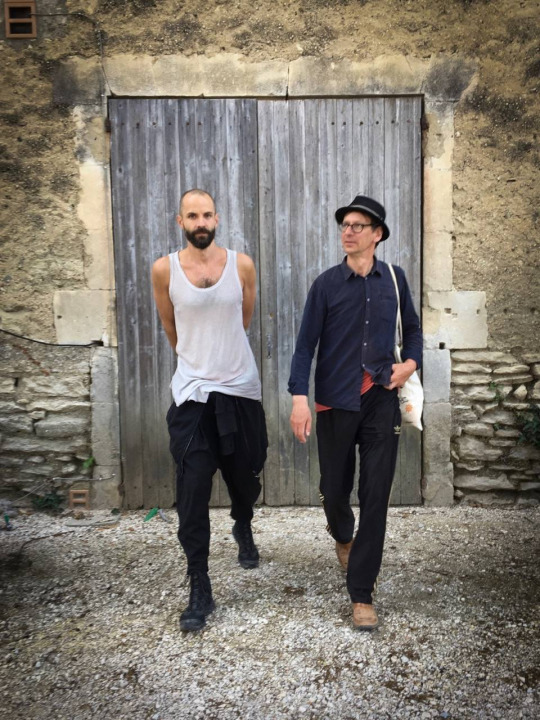




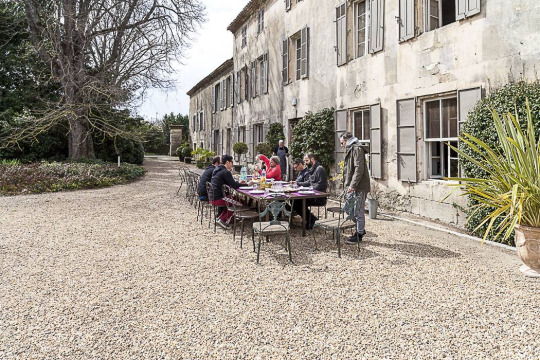
Jacob Hellner was no longer involved, his role was taken over by Olsen Involtini. In late summer 2018, the orchestral and choir parts were recorded in Minsk. In December of the same year, 11 of the 16 songs were mixed by Rich Costey, Olsen Involtini, and Richard in Santa Monica, California.


As a teaser for the album, a tracklist with placeholders for letters and durations was released in 2019, hinting at the song titles:
DEUTSCHLAND – 05:26
+ADI+ – 03:00
++++ DICH – 03:00
A+S+Ä+D+R – 03:00
++X – 03:00
P+PP+ – 03:00
+AS +CH ++E++ – 03:00
+IA+AN+ – 03:00
WE++ WE+ – 03:00
+A++OO – 03:00
+ALL++ANN – 03:00
Audio snippets, each featuring a short instrumental segment from one of the songs, gave further clues to the tracks.
Starting on the album’s release day, a large truck toured various cities in Germany, Poland, the Netherlands, Belgium, and Austria. At each stop, visitors were given a special code they could use to win 2x2 tickets to the sold-out shows of the 2019 Europe Stadium Tour.
The album itself was visually dominated by the colors white and white. A making of video was released showing the photo shoot, which featured photographer Jes Larsen working with the band.






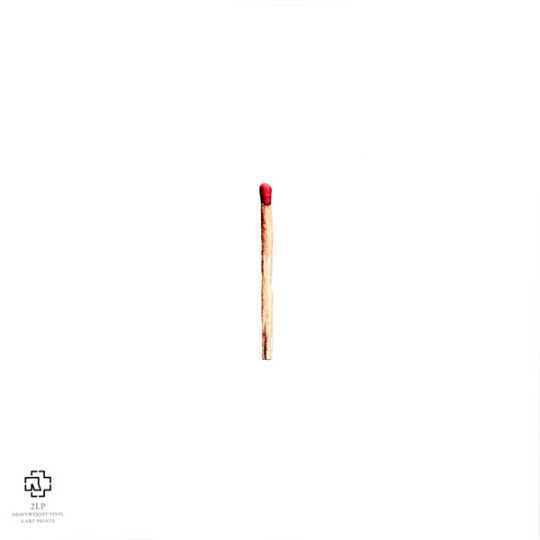
More little facts:
If you ordered the album in Germany from Saturn or MediaMarkt, you received a free promotional T-shirt, which has still never been officially released. Another special promotion took place in Long Beach, California: if you bought the album at the store Fingerprints Music, you had the chance to receive a free Rammstein logo tattoo.
The song “Deutschland” triggered a wave of outrage in Germany, as it was frequently misinterpreted and the music video was considered offensiven - particularly due to its references to the Holocaust.
The music video for “Radio” was projected onto a building wall in Berlin-Mitte on April 25, 2019, at 8:55 p.m., shortly before the album’s release. About 1000 fans attened the presentation:

Olsen Involtini also took on the role of mediator during the creative process. Richard reported the following: “Because of his presence, the energy between Paul and I changed dramatically. I don’t know why. It’s almost like couples therapy. It’s not about going there and getting advice from a therapist. It’s more about if you go to a therapist and you’re sitting in front of another person, you’re listening to what the other person is saying, and while they’re saying something, you’re thinking of strategies on how to fight against it. So, all of a sudden, I was listening to what he was saying and he was listening to what I was going to say. Individually, we are very, very different. Black and white. If he says ‘Yes,’ I say ‘No.’ It’s always the same story. But somehow we need that for the Rammstein universe.” (Revolver)
Sources: rammsteinworld rammwiki affenknecht discogs dw.com kerrang
#almost forgot this was in my drafts over all the weird stuff that's happening lately#happy birthday untitled!#rammstein#till lindemann#richard kruspe#paul landers#christoph schneider#flake lorenz#oliver riedel#album anniversary#quotes & interviews#research & rammsplaining
79 notes
·
View notes
Text
Fiat Lingua Top 10 for 2024
It's time for the annual Fiat Lingua rewind!
Background: I created Fiat Lingua over ten years ago with the idea that it could be something like the Rutgers Optimality Archive: A place where conlangers could post work that they wanted to showcase, or work that was in progress. We've had tons of contributions over the years, and some standout work I'm really proud of.
Using our fancy statistics program (you know, the free version) we're able to determine the top 10 visited posts for this year (though, note, the numbers for the current year's December post will always be down a little bit, since it didn't have a full month. If you'd like to take a look at it, Carl Buck created a new workable orthography for Klingon from the original!). Here they are!
NUMBER 10
We have a tie...
"A Naming Language" (November, 2016) by Jeffrey Henning: A fantastic (and short!) essay about how to create a conlang sketch (or naming language) specifically aimed at authors. The author, Jeffrey Henning, was the most important person in conlanging from the 90s through the mid-2000s before his seminal website, Langmaker.com, died.
"Down with Morphemes: The Pitfalls of Concatenative Morphology" (March, 2014) by David J. Peterson: Honestly, I'm touched. And baffled. Why this paper, published ten years ago which hasn't touched the top ten the past two years, is suddenly on it is absolutely beyond me.
NUMBER 9
"Afrihili: An African Interlanguage" (April, 2014) by William S. Annis: Afrihili is an a posteriori auxlang from the late 60s that uses Bantu languages as its source. If you haven't read about it, you must. This article took sixth place the past two years, but this year dropped to ninth!
NUMBER 8
"Tone for Conlangers: A Basic Introduction" (April, 2018) by Aidan Aannestad: This is the third time this article has been in the top 10, but it slipped one place to number 8. Conlangers continue to find this introduction to tone quite valuable.
NUMBER 7
"Names Aren’t Neutral: David J. Peterson on Creating a Fantasy Language" (March, 2019) by David J. Peterson: Down two spots from last year, this is my article on best practices when coming up with names in a fantasy setting—even when no conlang is present.
NUMBER 6
"Introduction, A Note on the Terminology and Linguistic Methodology of This Paper, and Section I" (February, 2012) by Madeline Palmer: So...this came out of nowhere. This was an early series that helped me avoid having to do a bunch of work for Fiat Lingua in the early years. I was grateful for the runway! I have no idea why, after more than ten years, the dragon language Srínawésin is now getting attention after getting next to none in the past, but…it's getting attention—in a big way. Anyone know why?
NUMBER 5
"Patterns of Allophony" (April, 2015) by William S. Annis: Definitely one of the most popular papers on Fiat Lingua, William illustrates graphically a number of very common sound changes. This article has been at #3 the past two years but tumbled two spots this year to #5.
NUMBER 4
"Hieroglyphs of Fneise" (April, 2024) by Jason Lynn: New to Fiat Lingua this year and new to the top ten, everyone loved this new article about the hieroglyphs of Fneise, created by Jason Lynn, friend of LangTime Studio!
NUMBER 3
"A Conlang-Venture: A Select-A-Feature Adventure" (January, 2024) by Jessie Peterson: This MAMMOTH .pdf is honestly one of the greatest conlang achievements ever. Clocking in at over 700 pages, Jessie created a hyperlinked choose-your-own-adventure demonstration of how to evolve a naturalistic conlang. This document is nothing short of amazing.
NUMBER 2
"Grambank & Language Documentation: Zhwadi and Its Features" (June, 2023) by Jessie Peterson: Even her massive conlang-venture .pdf couldn't top her incredible resource from last year. This is a short description of how to use Grambank in conlanging with a link to a fillable Google spreadsheet any conlanger can copy and use to introduce their conlang to others. Last year this made #4 on the list, and this year it jumped two spots!
And now for the top viewed article for 2024 on Fiat Lingua...
NUMBER 1
"A Conlanger's Thesaurus" (September, 2014) by William S. Annis: The king is back! Last year my article on how to create a surreal conlang took the top spot. This year? Not even in the top THIRTY! It's like it was wiped off the face of the internet! Whether it's top spot or not, though, William Annis's resource on how to create unique words with unique interrelationships and associations has proved useful to conlangers of all stripes. As a reference work, it is unparalleled in terms of usefulness modulo brevity.
* * * * *
And that's it for 2024! I'm looking forward to posting more conlang articles next year. If you are a conlanger, a conlang-researcher, or conlang fan who has something to say in .pdf format about a specific conlang or conlanging in general, please consider submitting something to Fiat Lingua! We take any and all articles related to conlanging in whatever form you have them. I'm also happy to help you think up ideas, or refine those ideas you have. There is no strong review like in a fancy journal: I just want to get what you have up. I'm especially in interested in hosting personal conlang stories—stories about how or why you started to create a language, or your experience creating your own language—personal stories that are often lost, but are so vital, as there is an absolute dearth of literature about conlangers! If you think you have even the seed of an idea, please get a hold of me! I want to share as many stories and ideas as I can.
#conlang#fiat lingua#jessie peterson#william annis#william s annis#jason lynn#fneise#afrihili#grambank#linguistics#language#lcs#madeline palmer#aidan aannestad#language creation#srínawésin#jeffrey henning#language invention#carl buck#klingon
92 notes
·
View notes